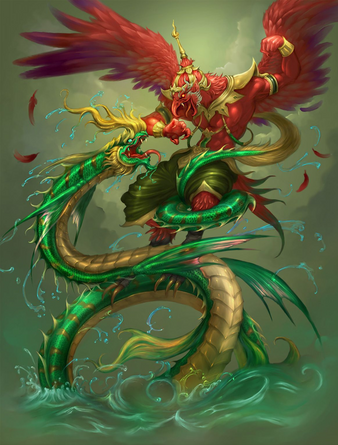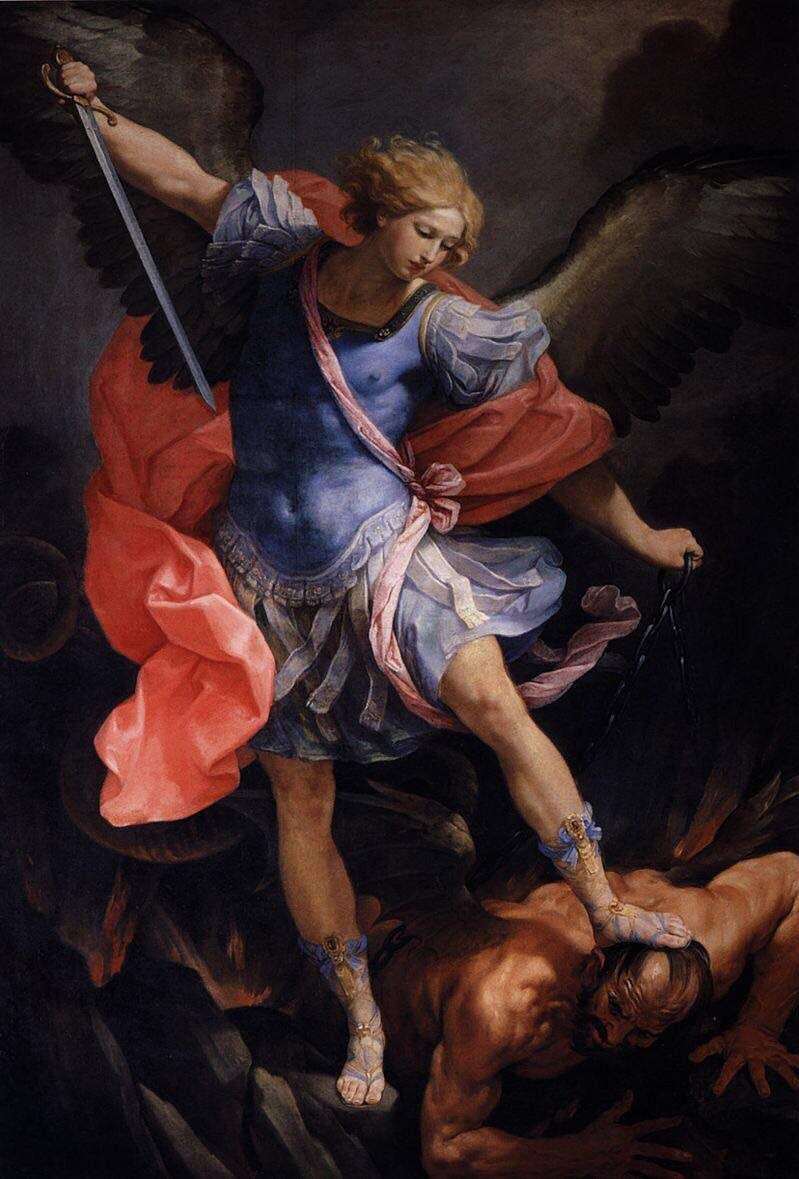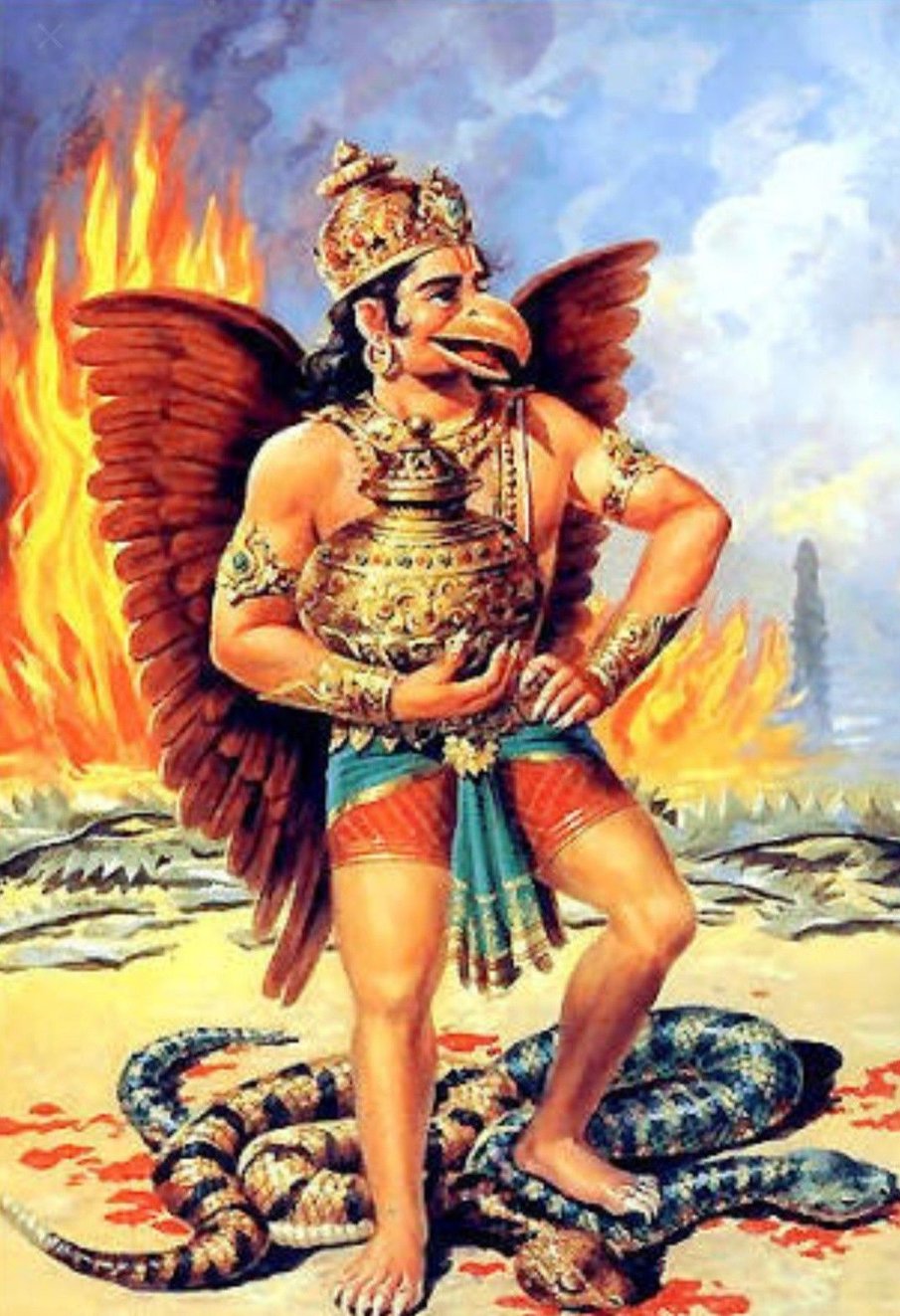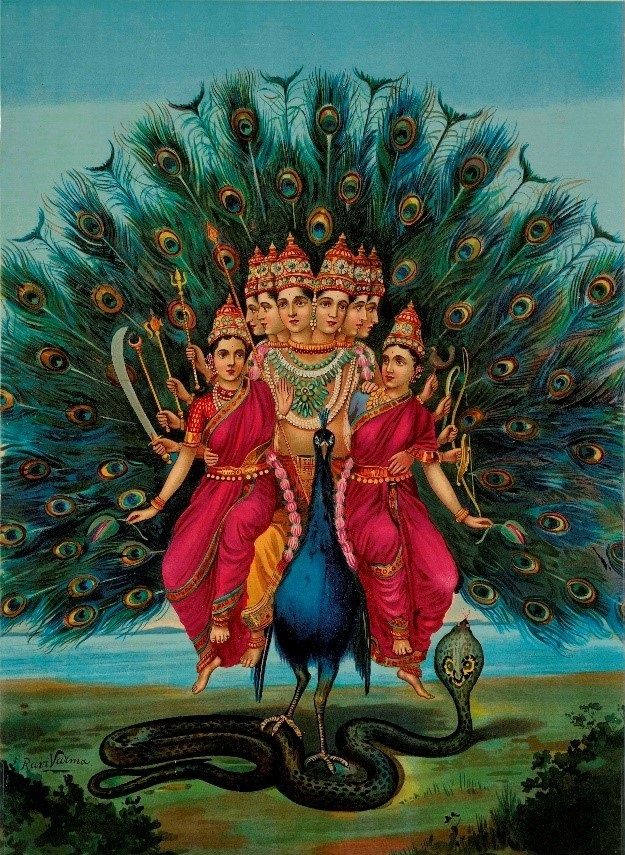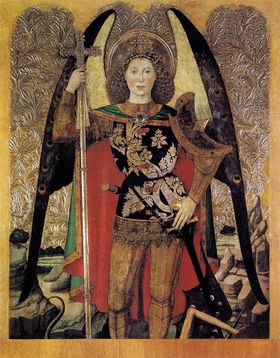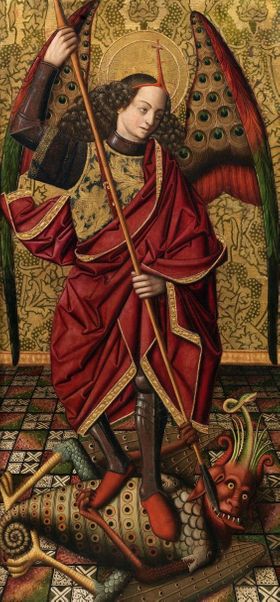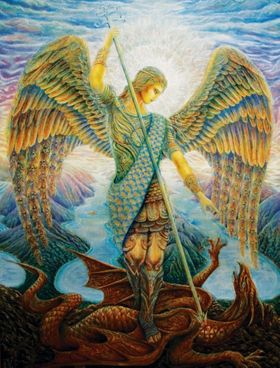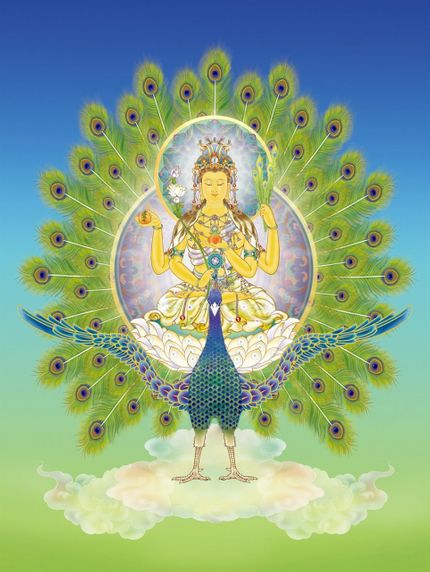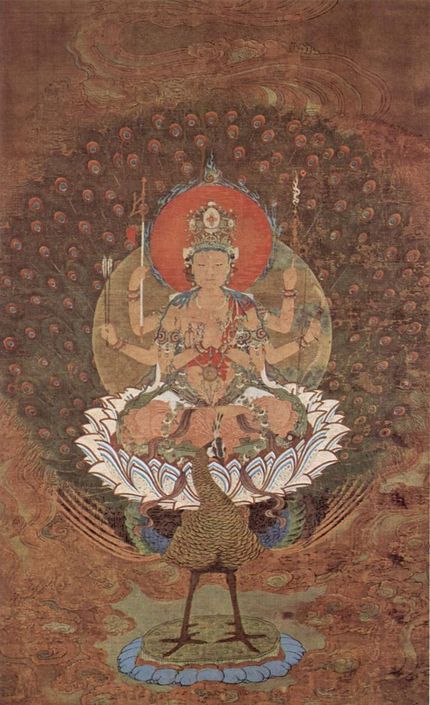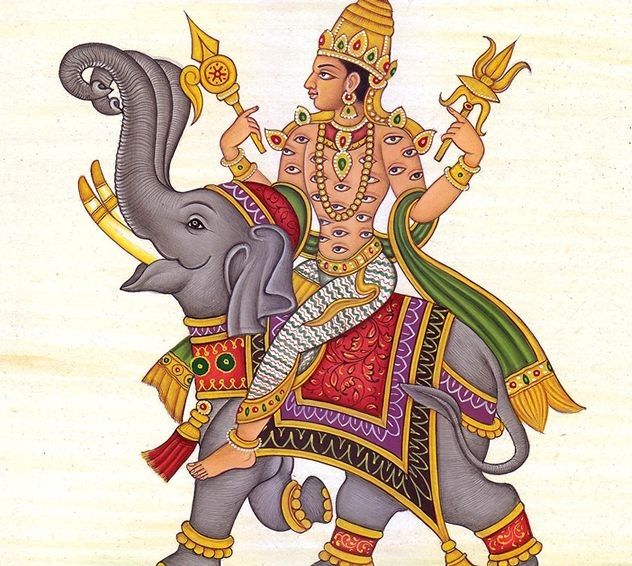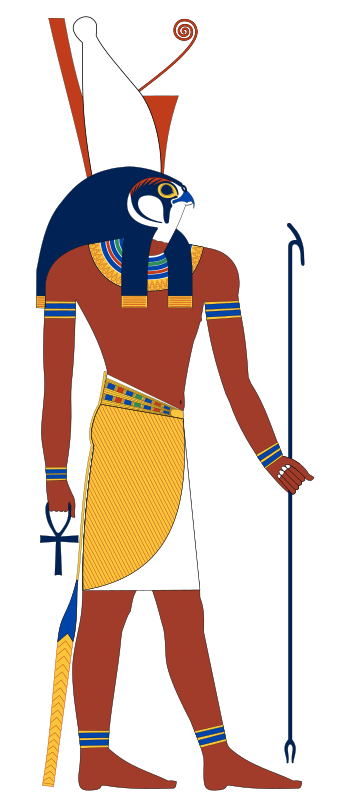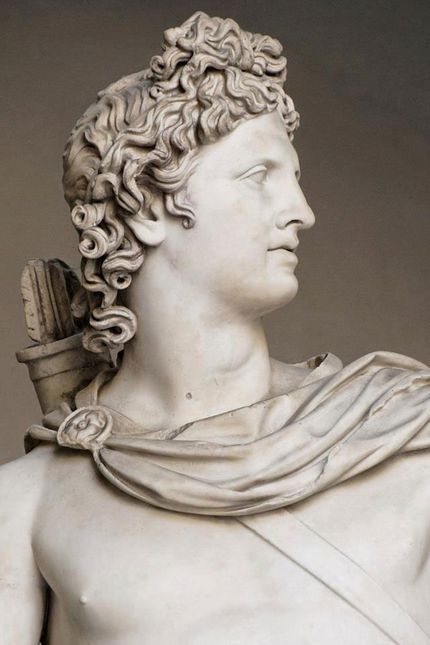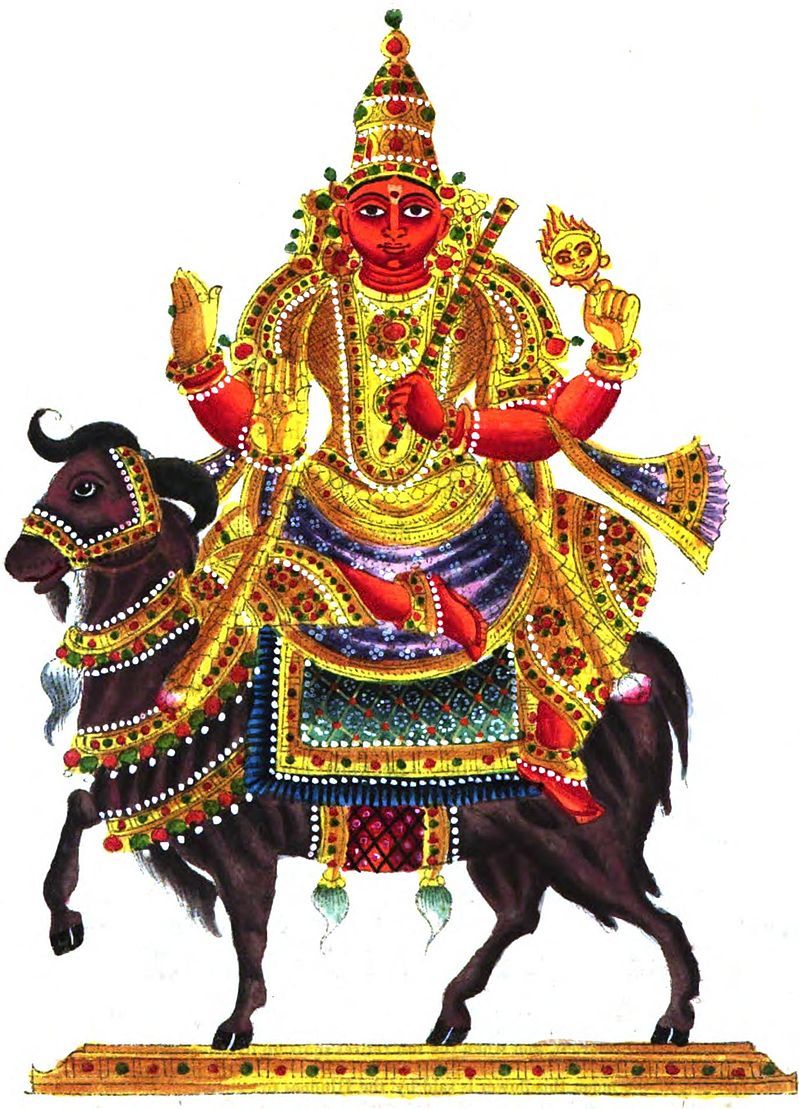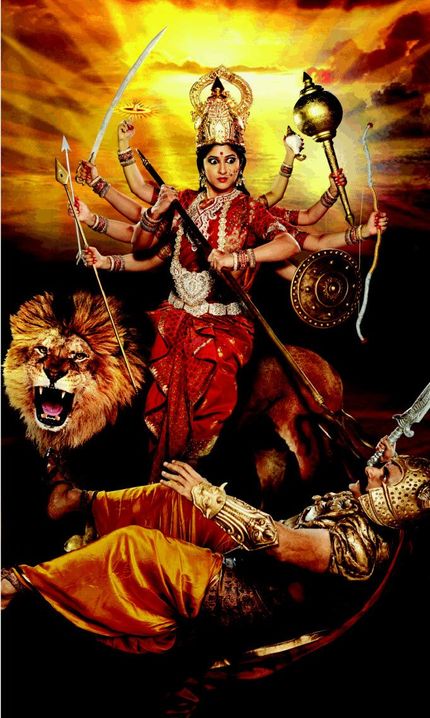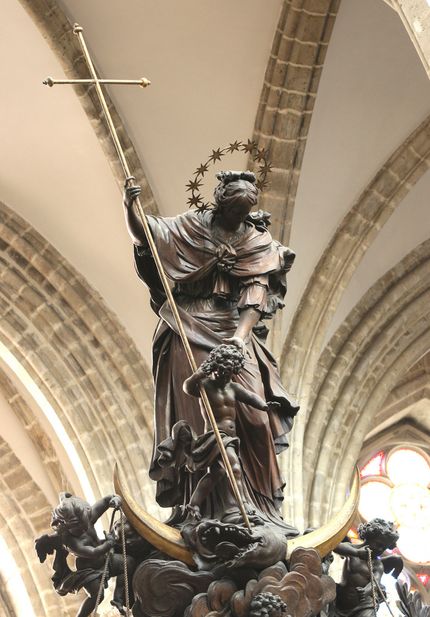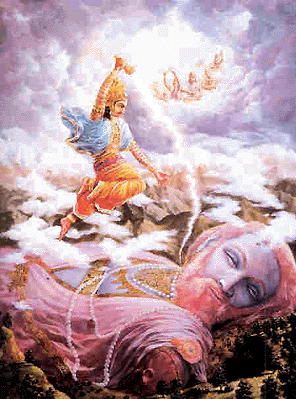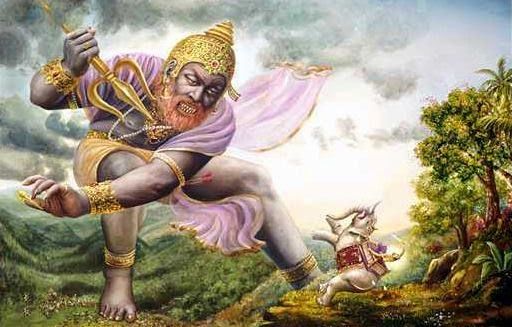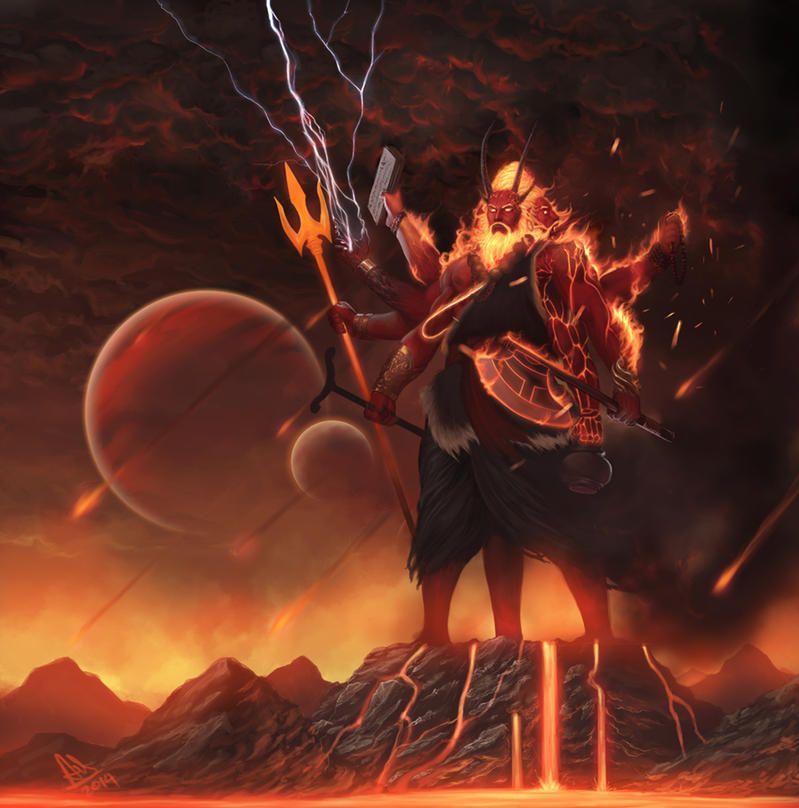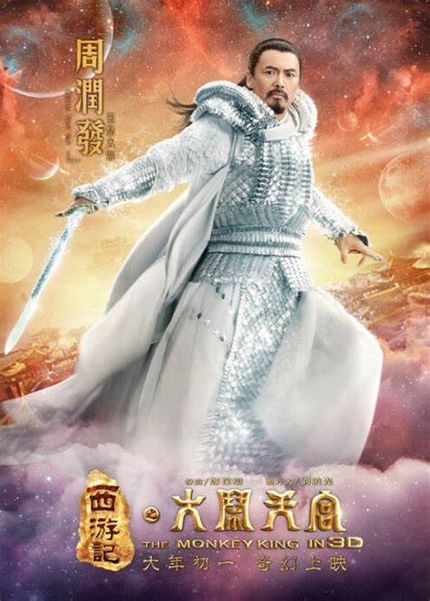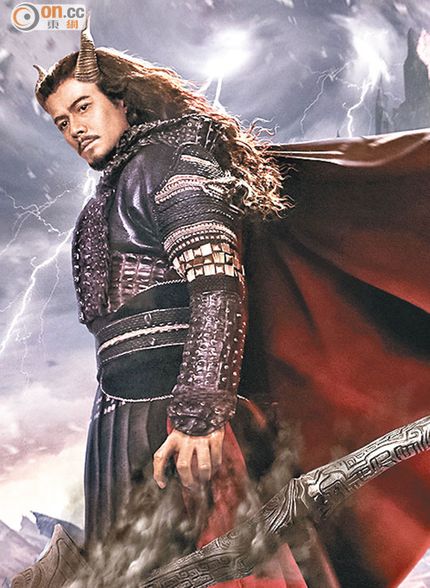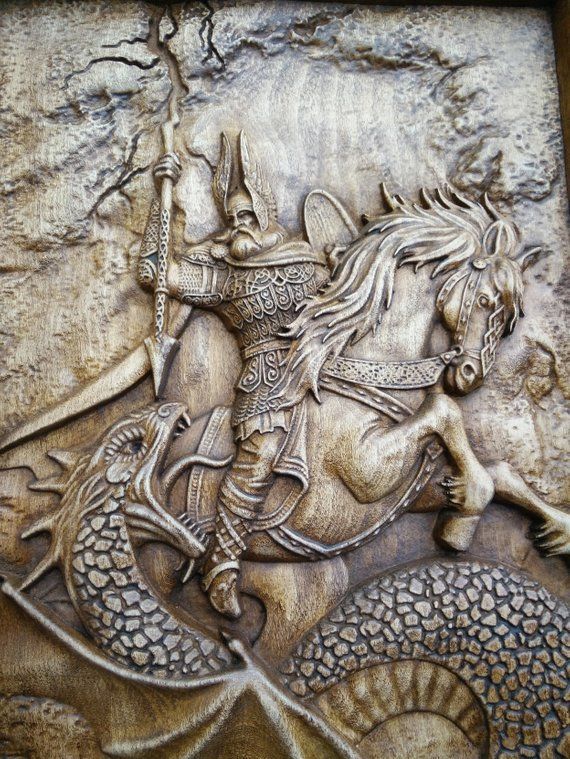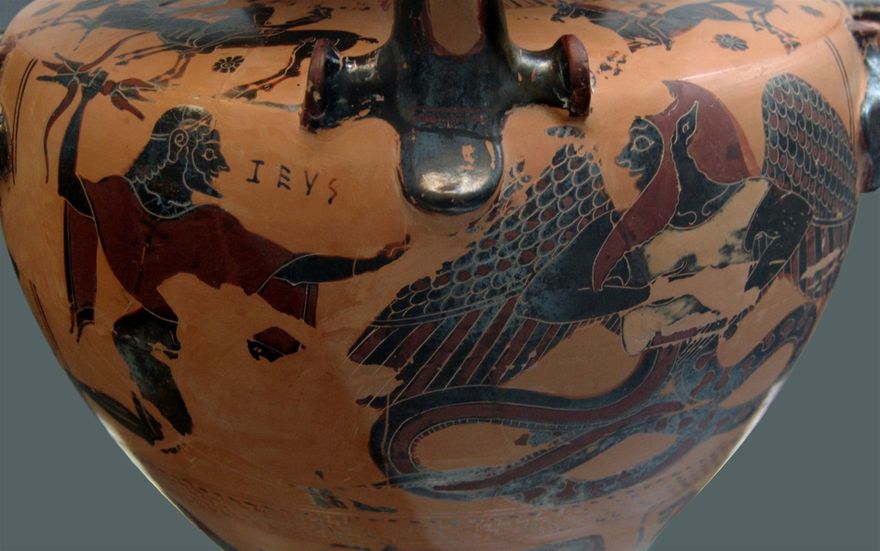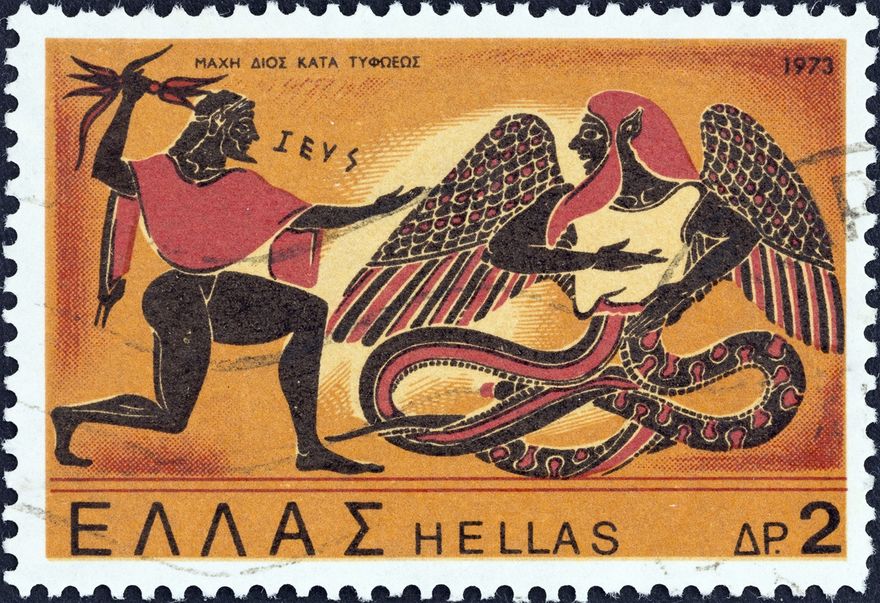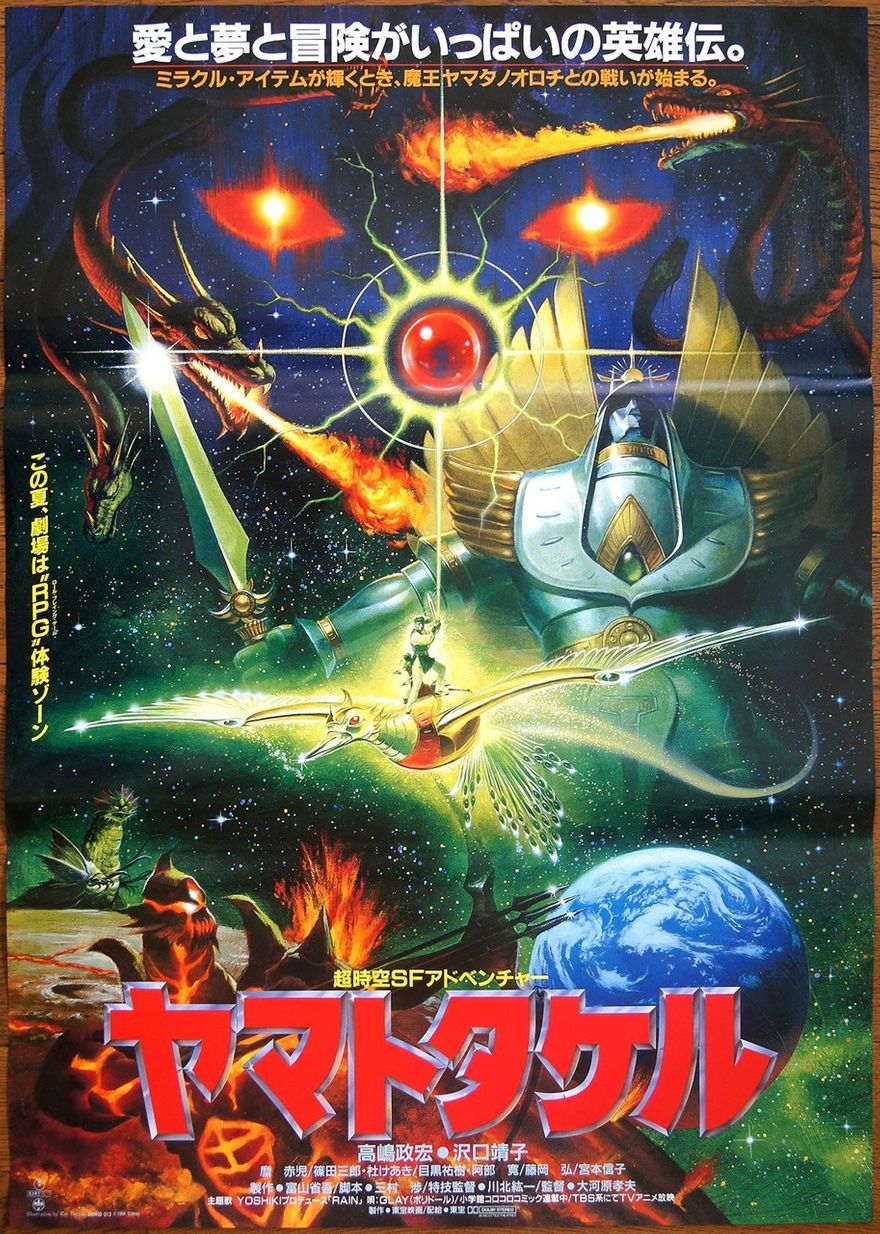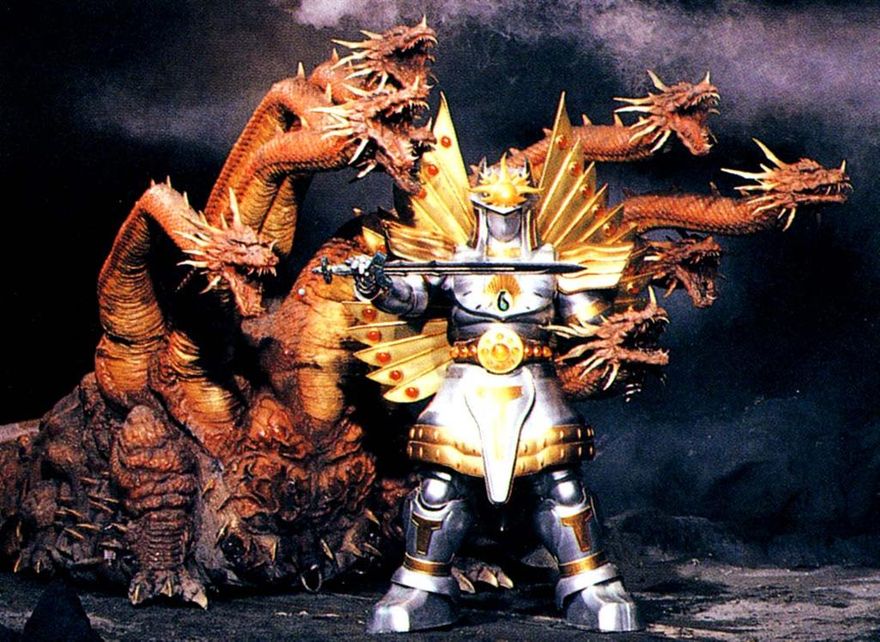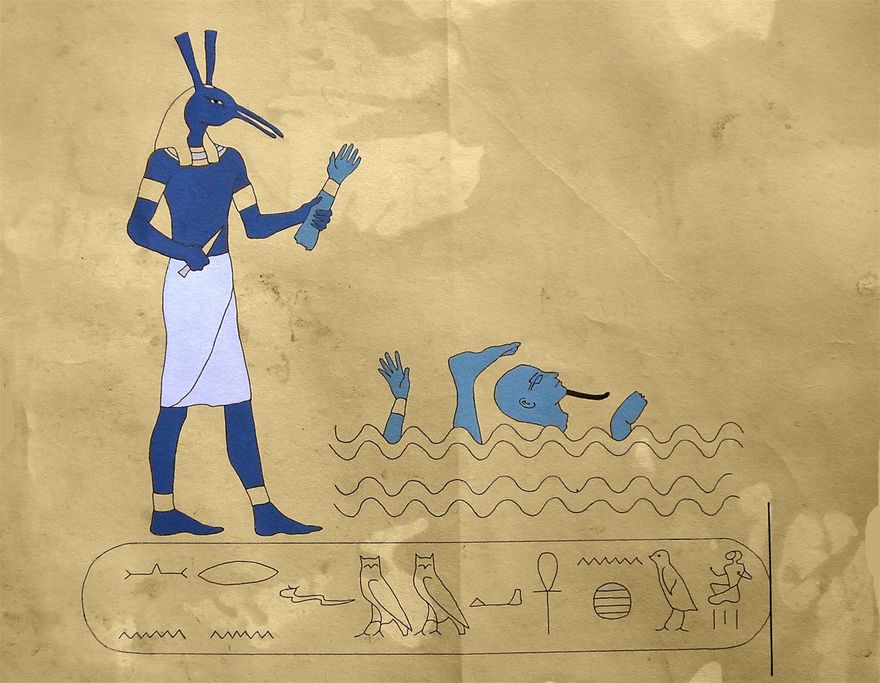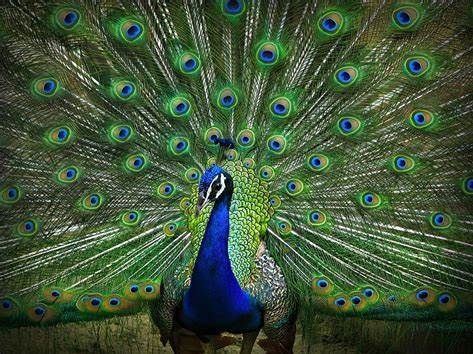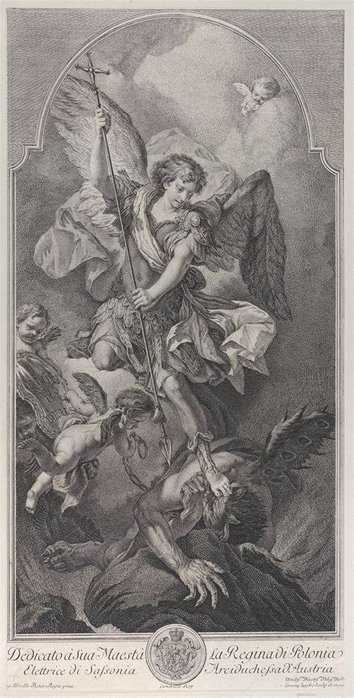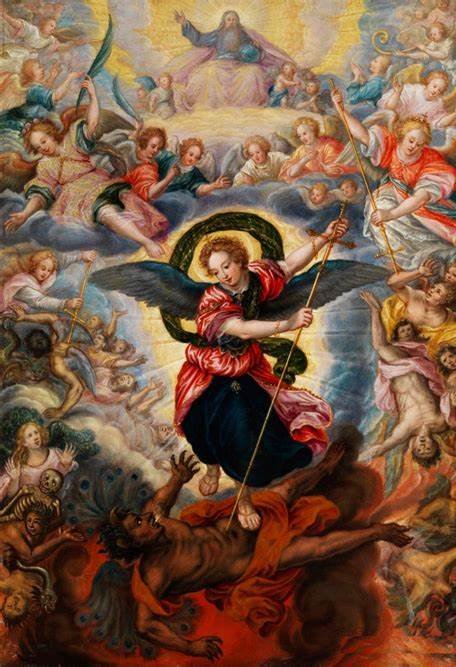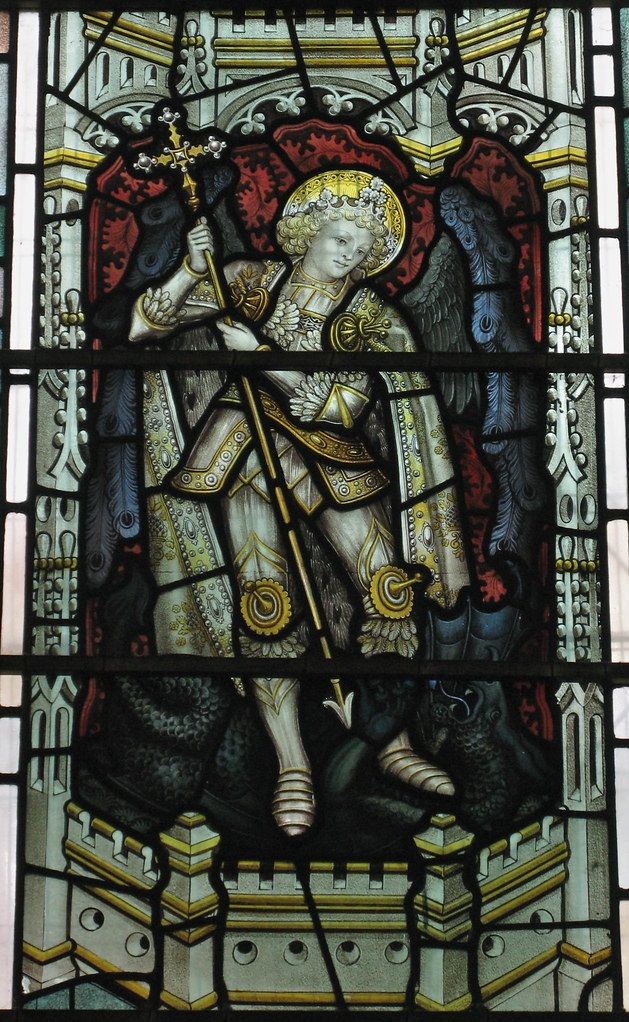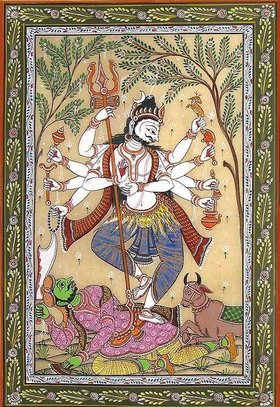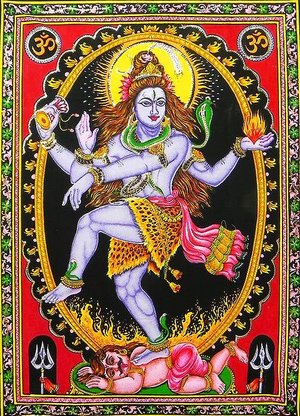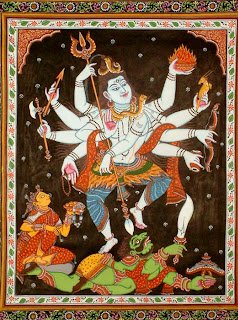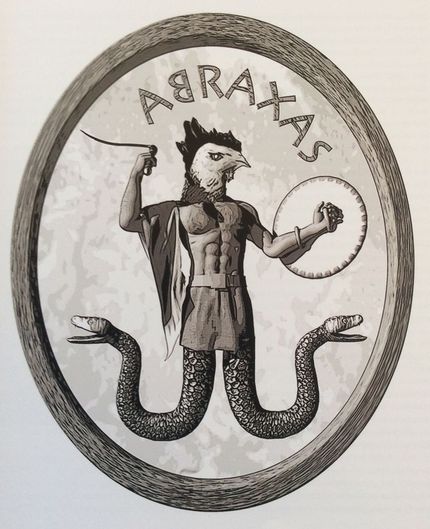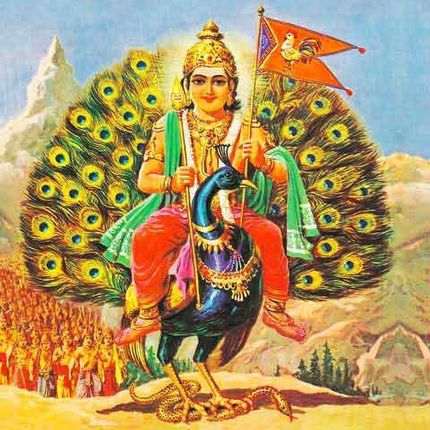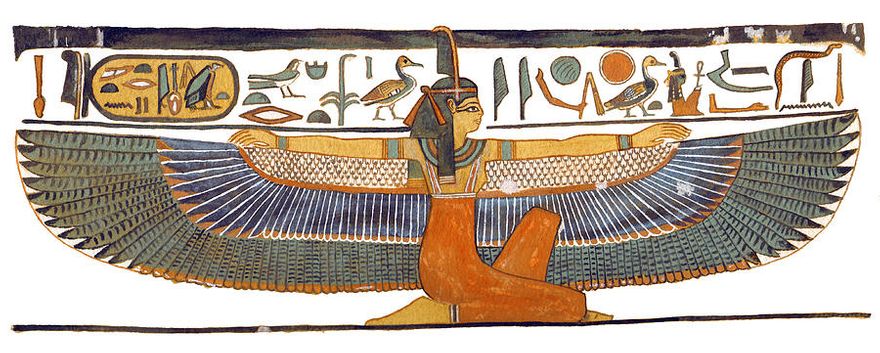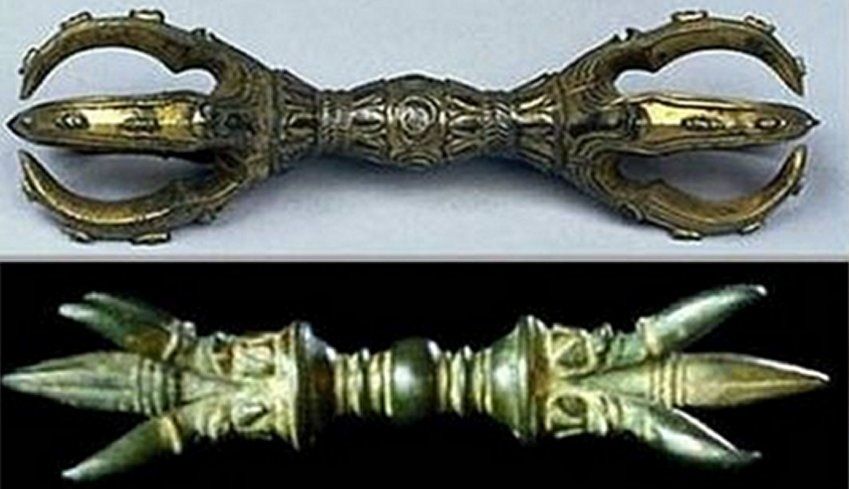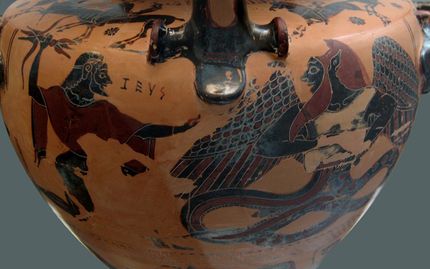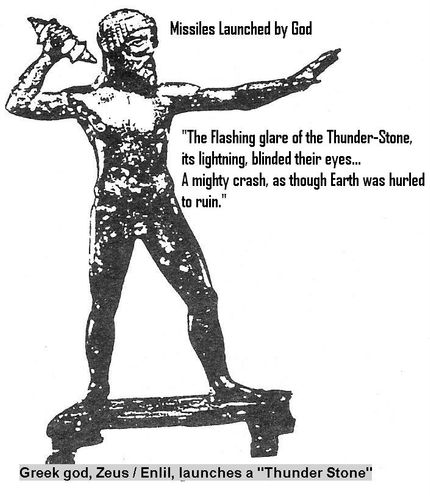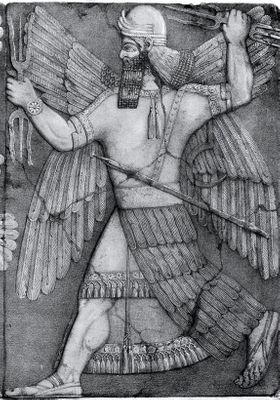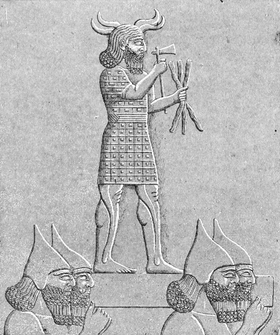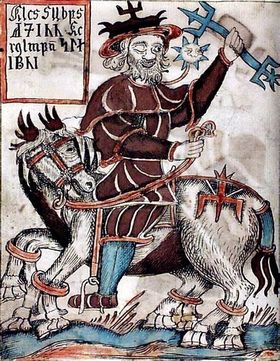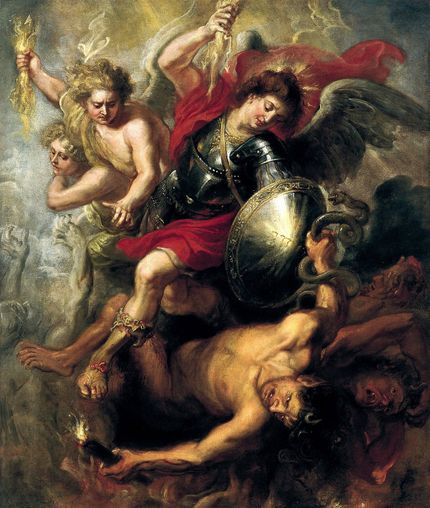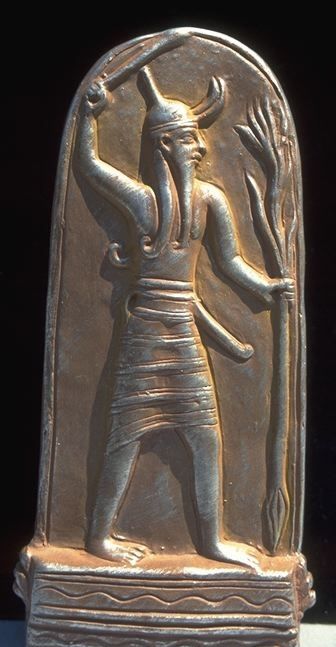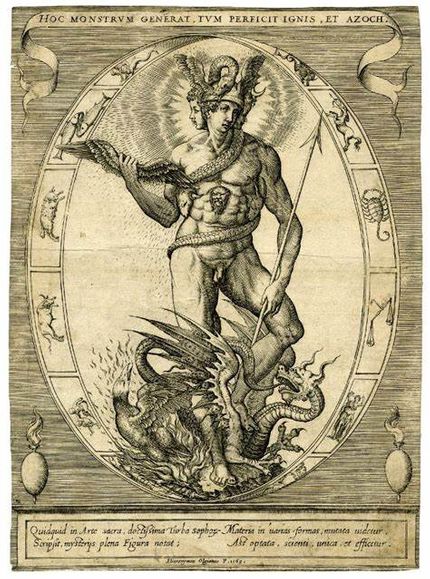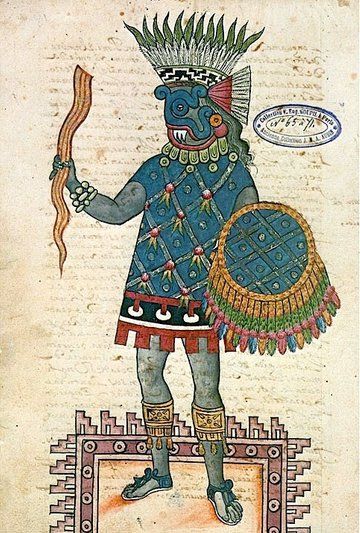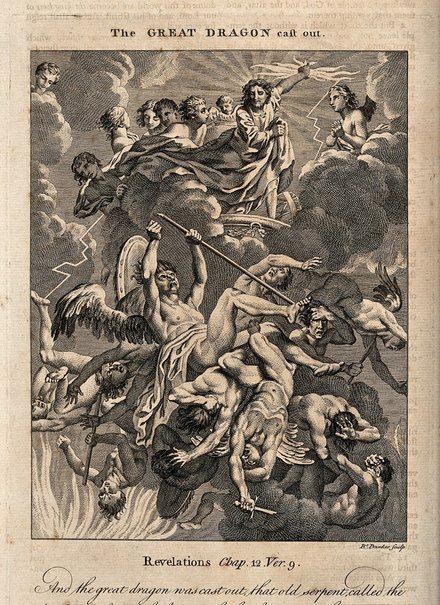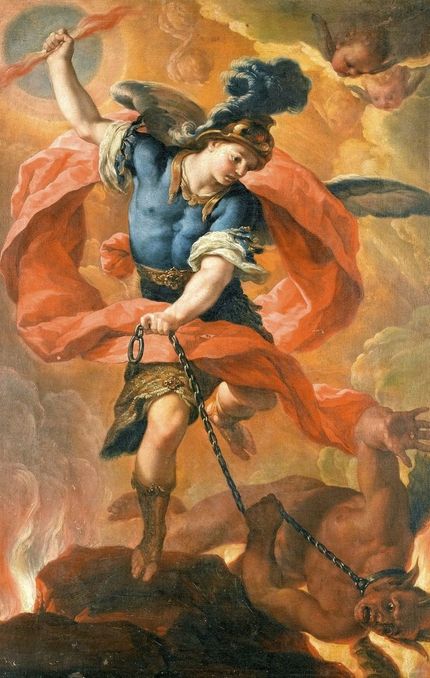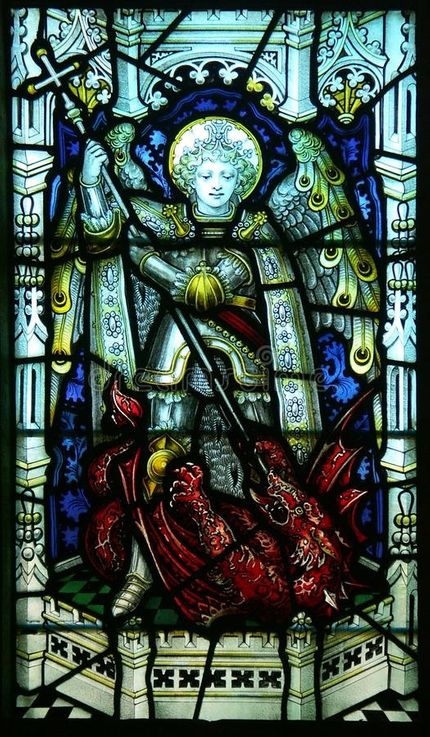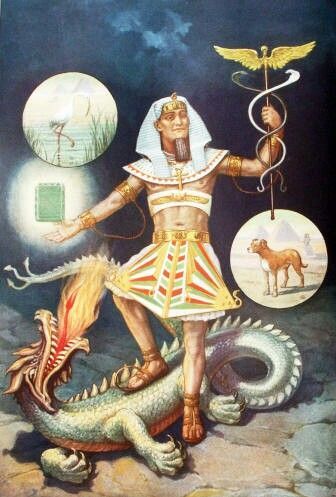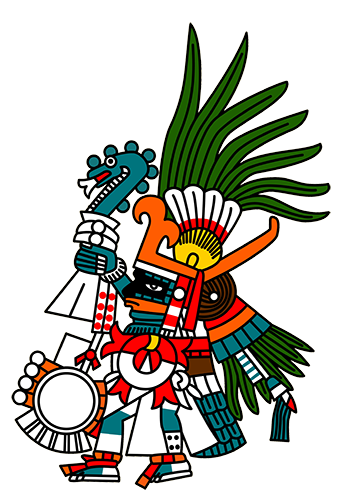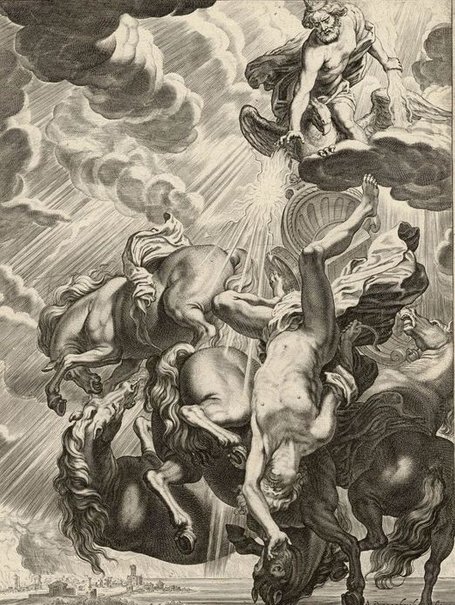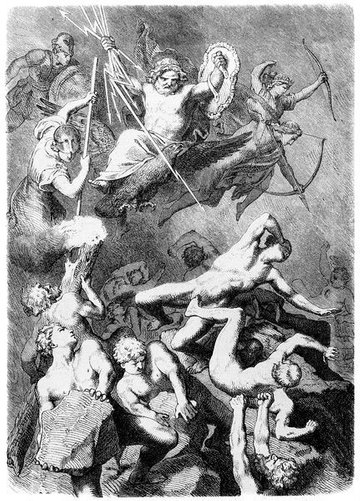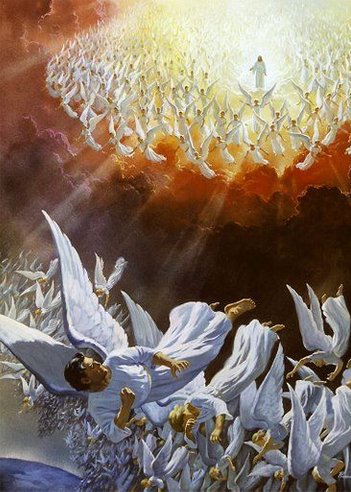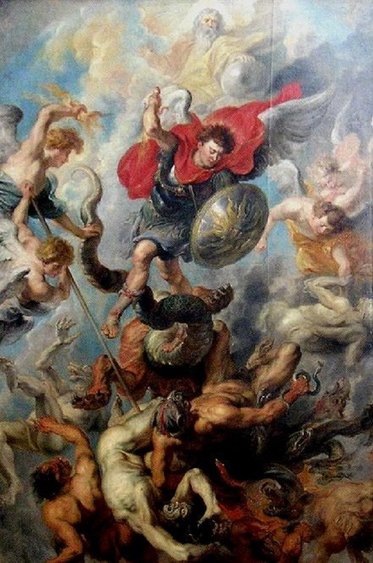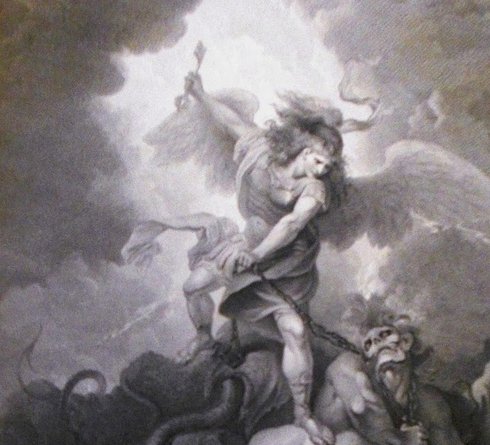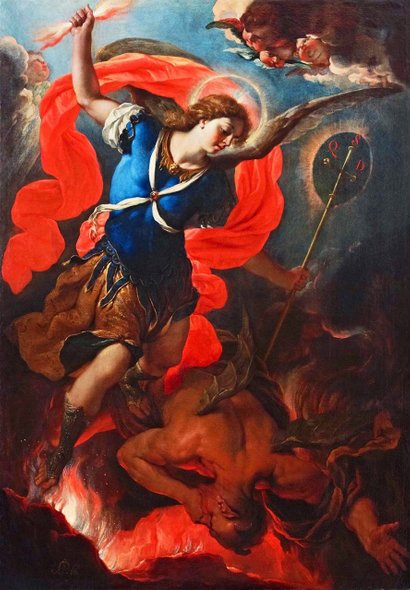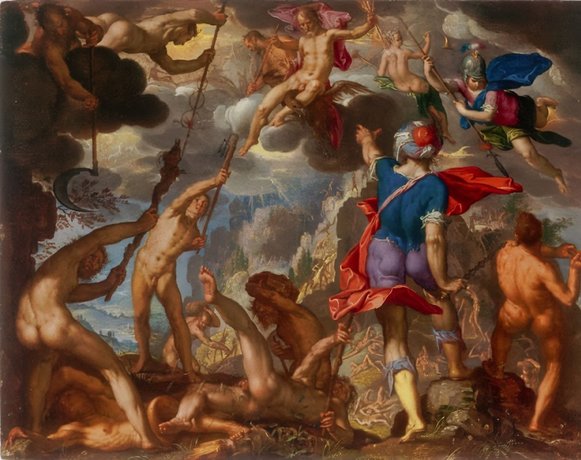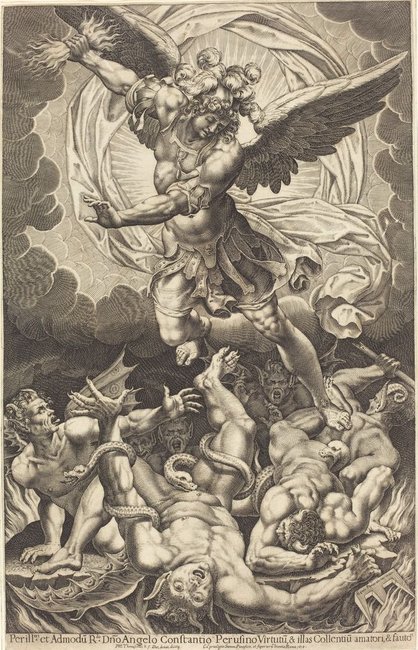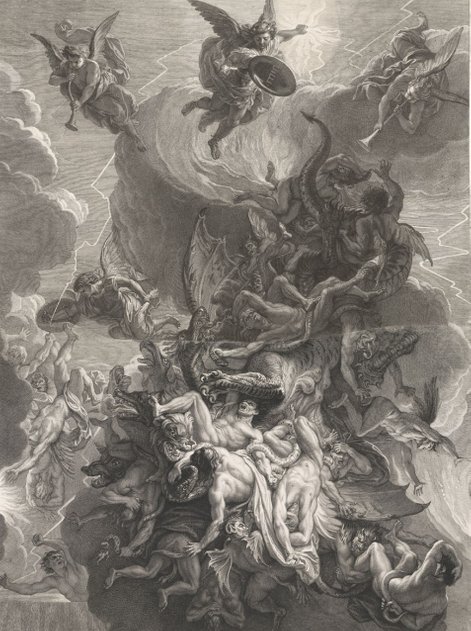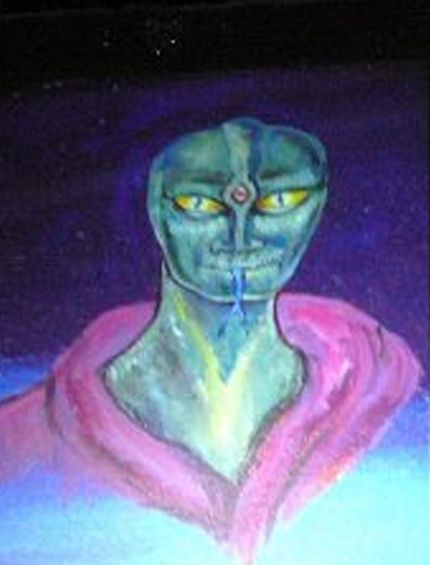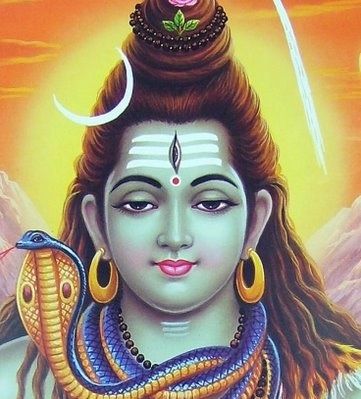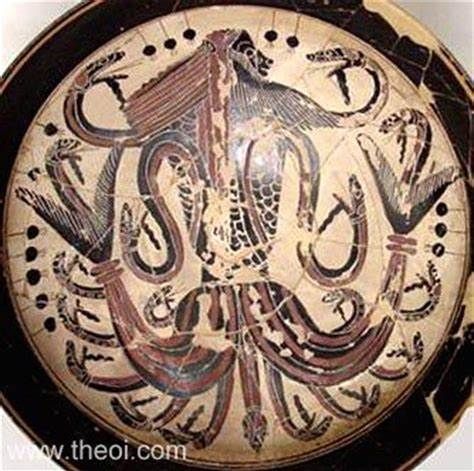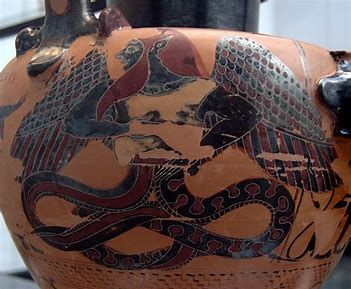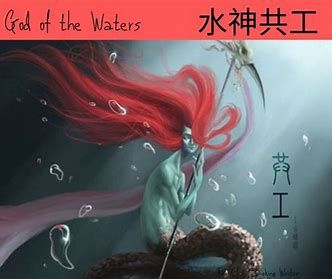Revelations 12:7-12 states this: "7And there was war in heaven: Michael and his angels fought against the dragon; and the dragon fought and his angels, 8And prevailed not; neither was their place found any more in heaven. 9And the great dragon was cast out, that old serpent, called the Devil, and Satan, which deceiveth the whole world: he was cast out into the earth, and his angels were cast out with him. 10And I heard a loud voice saying in heaven, Now is come salvation, and strength, and the kingdom of our God, and the power of his Christ: for the accuser of our brethren is cast down, which accused them before our God day and night. 11And they overcame him by the blood of the Lamb, and by the word of their testimony; and they loved not their lives unto the death. 12Therefore rejoice, ye heavens, and ye that dwell in them. Woe to the inhabiters of the earth and of the sea! for the devil is come down unto you, having great wrath, because he knoweth that he hath but a short time."
Now, based from this battle details the war between two groups, as I had stated in the previous Chapters, the war between the two groups (as Suras and Asuras) is where this story starts. It's rather interesting that Michael is compared to the "lamb", to which seems to connect to "Agni and the lamb" references. But first when you see Michael stepping on the Dragon, is merely Garuda stepping on the Naga, to which connects to Genesis 3:15 “And I will put enmity between thee and the woman, and between thy seed and her seed; it shall bruise thy head, and thou shalt bruise his heel.”
As stated from the symbolism, I will list down many stories detailing this battle.
Now, when I was looking up the stories based on "Melek Taus" being the Peacock Angel I find that the story is rather mixed up, because they state that one of many incarnations of Melek Taus is Osiris, however, based from learning more about this subject tells me that the story of the fire God Set battling Osiris is basically the same story, as this connects to the Garuda vs Naga story. Though the roles are reversed to the bird God Horus battling Set, the story remains the same as the attributes of the Gods is passed down to newer created deities. We can see that as the roles are then reversed, the story of Set takes the place as the one who gets defeated by Horus in this form as well. Now, based from seeing some pictures of Michael's wings with Peacock feathers gave me the indication that this is the Hindu God Murugan, as the Peacock Angel and one of the incarnations of Melek Taus. However, it's shown that the "Peacock" symbology was the one of the subjects that threw me off a bit, because the Peacock symbology would also be shown as one of the symbols belonging to the dragon God. This will make sense later on in this Chapter.
Now, when learning looking up the website "Yeziditruth.org", the legend states how Melek Taus has different manifestations that represents him in someways. However, nowadays this website seems to be taken down, but I'll clue the reader as to the different Avatars of this being. One he is called "Murugan" the Peacock Warrior, who would the son of Shiva and Parvati, and the brother of Ganesh. He is also called "Skanda" or "Kartikeya" as well. Here are some excerpts from the Wiki:
"Kartikeya, also known as Skanda, Kumara, Murugan, Mahasena, Shanmukha and Subrahmanya, is the Hindu god of war. He is a son of Parvati and Shiva, brother of Ganesha, and a god whose life story has many versions in Hinduism. An important deity in the Indian subcontinent since ancient times, Kartikeya is particularly popular and predominantly worshipped in South India, Sri Lanka and Malaysia as Murugan. Kartikeya is an ancient god, traceable to the Vedic era. Archaeological evidence from 1st-century CE and earlier, where he is found with Hindu god Agni (fire), suggest that he was a significant deity in early Hinduism. He is found in many medieval temples all over India, such as at the Ellora Caves and Elephanta Caves."
"The iconography of Kartikeya varies significantly; he is typically represented as an ever-youthful man, riding or near an Indian Peacock, called Paravani, dressed with weapons sometimes with a rooster in the flag he holds. Most icons show him with one head, but some show him with six heads reflecting the legend surrounding his birth. He grows up quickly into a philosopher-warrior, destroys evil in the form of demon Taraka, teaches the pursuit of ethical life and the theology of Shaiva Siddhanta. He has inspired many poet-saints, such as Arunagirinathar."
"Kartikeya is found as a primary deity in temples wherever communities of the Tamil people live worldwide, particularly in Tamil Nadu state of India, Sri Lanka, Mauritius, Indonesia, Malaysia, Singapore, South Africa and Réunion. Three of the six richest and busiest temples in Tamil Nadu are dedicated to him. The Kataragama temple dedicated to him in Sri Lanka attracts Tamils, Sinhalese people and the Vedda people. He is also found in other parts of India, sometimes as Skanda, but in a secondary role along with Ganesha, Parvati and Shiva."
"Kartikeya is known by numerous names in ancient and medieval texts of the Indian culture. Most common among these are Murugan, Kumara, Skanda, and Subrahmanya. Others include Aaiyyan, Cheyyon, Senthil, Vēlaṇ, Swaminatha ("ruler of the gods", from -natha king), śaravaṇabhava ("born amongst the reeds"), Arumugam or ṣaṇmukha ("six-faced"), Dandapani ("wielder of the mace", from -pani hand), Guha (cave, secret) or Guruguha (cave-teacher), Kadhirvelan, Kathiresan, Kandhan, Vishakha and Mahasena. In ancient coins where the inscription has survived along with his images, his names appear as Kumara, Brahmanya or Brahmanyadeva."
"On some ancient Indo-Scythian coins, his names appear in Greek script as Skanda, Kumara and Vishaka. In ancient statues, he appears as Mahasena, Skanda and Vishakha. Skanda is derived from skand-, which means "leap or attack". In Kalidasa’s epic poem Kumarasambhava (“The Birth of the War God”; 5th century CE), as in most versions of the story, the gods wished for Skanda to be born in order to destroy the demon Taraka, who had been granted a boon that he could be killed only by a son of Shiva. They sent Parvati to induce Shiva to marry her."
"Shiva, however, was lost in meditation and was not attracted to Parvati until he was struck by an arrow from the bow of Kama, the god of love, whom he immediately burned to ashes. After many years of abstinence, Shiva’s seed was so strong that the gods, fearing the result, sent Agni, the god of fire, to interrupt Shiva’s amorous play with Parvati. Agni received the seed and dropped it into the Ganges, where Skanda was born. Kartikeya means "of the Krittikas".
"This epithet is also linked to his birth. After he appears on the banks of the River Ganges, he is seen by the six of the seven brightest stars cluster in the night sky called Krittikas in Hindu texts (called Pleiades in Greek texts). These six mothers all want to take care of him and nurse baby Kartikeya. Kartikeya ends the argument by growing five more heads to have a total of six heads so he can look at all six mothers, and let them each nurse one. The six Krittikas are Śiva, Sambhūti, Prīti, Sannati, Anasūya and Kṣamā."
In Tamil literature: "The Tolkāppiyam, one of the most ancient texts of the Tamil literature, mentions cēyōṉ "the red one", who is identified with Murugan, whose name is literally Murukaṉ "the youth"; the other gods referred to in the Tolkāppiyam are Māyōṉ "the dark one" (identified with Vishnu), Vēntaṉ "the sovereign" (identified with Indra) and Korravai "the victorious" (identified with Kali) and Varunan "the sea god". Extant Sangam literature works, dated between the third century BCE and the fifth century CE glorified Murugan, "the red god seated on the blue peacock, who is ever young and resplendent," as "the favoured god of the Tamils." Korravai is often identified as the mother of Murugan."
"In the Tirumurukāṟtruuppaṭai, he is called Muruku and described as a god of beauty and youth, with phrases such as "his body glows like the sun rising from the emerald sea". It describes him with six faces each with a function, twelve arms, his victory over evil, and the temples dedicated to him in the hilly regions."
Legends: "The Epic era literature of ancient India recite numerous legends of Kartikeya, often with his other names such as Skanda. For example, the Vana Parva of the Mahabharata dedicates chapters 223 to 232 to the legends of Skanda, but depicts him as the son of Agni and Svaha. Similarly, Valmiki's Ramayana dedicates chapters 36 and 37 to Skanda, but describes him as the child of deities Rudra (Shiva) and Parvati, whose birth is aided by Agni and Ganga."
"The legends of Kartikeya vary significantly, sometimes within the same text. For example, while the Vana Parva of the Mahabharata describes Skanda as the son of Agni, the Shalya Parva and the Anushasana Parva of the same text presents Skanda's legend as the son of Maheshvara (Shiva) and Parvati. In Vana Parva, the circumstances behind Kartikeya's birth legend do not involve Shiva and Parvati. Rather it is deity Agni who goes to a hermitage of seven married Rishis (sages) and meets their seven wives. He is sexually attracted to all seven, but none reciprocate. Svaha is present there and she is attracted to Agni, but Agni is not."
"According to the legend, Svaha takes the form of six of the wives, one by one, and sleeps with Agni. She does not take the form of Arundhati, Vasistha's wife, because of Arundhati's extraordinary virtuous powers. Svaha deposits the semen of Agni into the reeds of River Ganges, where it develops and then is born as six headed Skanda. A totally different legend in the later books of the Mahabharata make Shiva and Parvati as the parents. They were making love, but they are disturbed, and Shiva inadvertently spills his semen on the ground. Shiva's semen incubates in River Ganges, preserved by the heat of god Agni, and this fetus is born as baby Kartikeya on the banks of Ganges."
"Some legend state that he was the elder son of Shiva, others make him the younger brother of Ganesha. This is implied by another legend connected to his birth. Devas have been beaten up by Asuras led by Taraka, because Taraka had a boon from ascetic celibate yogi Shiva that only Shiva's son can kill him. Devas learn about this boon, and plan how to get Shiva into a relationship. So they bring Parvati into the picture, have her seduce yogi Shiva, and wed Parvati so that Skanda can be born to kill Taraka."
"According to Raman Varadara, Murugan or Kartikeya was originally a Tamil deity, who was adopted by north Indians. He was the god of war in the Dravidian legends, and became so elsewhere in the Indian subcontinent too. In contrast, G. S. Ghurye states that according to the archeological and epigraphical evidence, the contemporary Murugan, Subrahmanya and Kartikeya is a composite of two influences, one from south and one from north in the form of Skanda and Mahasena."
"He as the warrior-philosopher god was the patron deity for many ancient northern and western Hindu kingdoms, and of the Gupta Empire, according to Ghurye. After the 7th-century, Skanda's importance diminished while his brother Ganesha's importance rose in the west and north, while in the south the legends of Murugan continued to grow. According to Norman Cutler, Kartikeya-Murugan-Skanda of South and North India coalesced over time, but some aspects of the South Indian iconography and mythology for Murugan have remained unique to Tamil Nadu."
"Kartikeya's legends vary by region. For example, in the northern and western Indian traditions Kartikeya or Skanda is the perpetual celibate bachelor, though Sanskrit texts mention Devasena as his wife. However in the Tamil legends he has two consorts, Devayanai (identified with Devasena) and Valli. Many of the major events in Murugan's life take place during his youth, and legends surrounding his birth are popular in Tamil Nadu."
"This has encouraged the worship of Murugan as a child-God, very similar to the worship of the child Krishna in north India. Kartikeya's youth, beauty and bravery was much celebrated in Sanskrit works like the Kathasaritsagara. Kalidasa made the birth of Kumara the subject of a lyrical epic, the Kumārasambhava."
Now, based from this story should give the reader a clue that this is where the story of Michael the Archangel battling the Red Dragon is based on.
Now, look up the "Taraka demon" that fought against the Gods, before Muruga had defeated him. Based from the Wiki states this: "Tārakāsura or Tāraka, Tharakasuran, Tarakasura was a powerful asura in Hindu mythology. He was son of a powerful Asura Vajranaka and his wife Vajrangini. Taraka had three sons Tarakaksha, Vidyunmāli and Kamalaksha, who were known as Tripurasura."
"Tarakasura repeatedly defeated the gods until heaven was on the verge of collapse. Yet he had a clever boon that he could be defeated only by the son of Shiva, who was a complete yogi, given to severe austerities, far from any thoughts of marriage. However, Parvati who was re-incarnation of Sati, Shiva's wife and also incarnation of Aadi Shakti who was once a part of Shiva, in their Ardhanarishvara form. Eventually their son Kartikeya was born. Kartikeya killed Tarakasura and his brothers Simhamukhan and Surapadman who eventually became the mounts of Parvati and Kartikeya."
Now, let's compare this to Revelations 12:7-12: "7And there was war in heaven: Michael and his angels fought against the dragon; and the dragon fought and his angels, 8And prevailed not; neither was their place found any more in heaven. 9And the great dragon was cast out, that old serpent, called the Devil, and Satan, which deceiveth the whole world: he was cast out into the earth, and his angels were cast out with him."
"10And I heard a loud voice saying in heaven, Now is come salvation, and strength, and the kingdom of our God, and the power of his Christ: for the accuser of our brethren is cast down, which accused them before our God day and night. 11And they overcame him by the blood of the Lamb, and by the word of their testimony; and they loved not their lives unto the death.12Therefore rejoice, ye heavens, and ye that dwell in them. Woe to the inhabiters of the earth and of the sea! for the devil is come down unto you, having great wrath, because he knoweth that he hath but a short time."
Amongst the Tamil he would be called "Murugan", to the Yezidiz is Melek Taus, and to the Christians "Michael the Archangel". One of the versions of Murugan's birth states that he was originally born from Agni, prior to the story of Shiva and Parvati creating him. Now, based from the Yezidi Website would state (from what I remember) Melek Taus is "Michael the Archangel" and "Murugan". He is also "St. George" who slays the Dragon, he is called "The Green Man", "Osiris" as Lord of the Underworld, "Krishna", and "Dionysus" or "Bacchus". Now, as I had stated before, the story of Murugan came from the God called "Indra" to which is the original prototype, and would be called the "thousand eyed one" (due to the Peacock symbology), to other numerous figures resembling the Peacock symbology.
Based from Blavatsky's "The Secret Doctrine" states this: [[Vol. 2, Page]] 381 THE THEFT OF RAHU. "Let us take Agni the fire-god, Indra the firmament, and Karttikeya from the Hindus; the Greek Apollo; and Mikael, the "Angel of the Sun," the first of the AEons, called by the Gnostics "the saviour" -- and proceed in order. (1) Agni -- the fire-god -- is called in the Rig-Veda Vaiswanara. Now Vaisvanara is a Danava -- a giantdemon,* whose daughters Puloma and Kalaka are the mothers of numberless Danavas (30 millions), by Kasyapa,* and live in Hiranyapura, "the golden city," floating in the air."
"Therefore, Indra is, in a fashion, the step-son of these two as a son of Kasyapa; and Kasyapa is, in this sense, identical with Agni, the fire-god, or Sun (Kasyapa-Aditya). To this same group belongs Skanda or Karttikeya (god of War, the six-faced planet Mars astronomically), a Kumara, or virgin-youth, born of Agni** for the purpose of destroying Taraka, the Danava Demon, the grandson of Kasyapa by Hiranyaksha, his son,*** whose (Taraka's) yogi austerities were so extraordinary that they became formidable to the gods, who feared such a rival in power."
"While Indra, the bright god of the Firmament, kills Vritra (or Ahi), the Serpent-Demon -- for which feat he is called Vritra-han, "the destroyer of Vritra"; he also leads the hosts of Devas (Angels or gods) against other gods who rebel against Brahma, for which he is entitled Jishnu, "leader of the celestial Host." Karttikeya is found bearing the same titles. For killing Taraka, the Danava, he is Taraka-Jit, "Vanquisher of Taraka,"***** "Kumara Guha," "the mysterious Virgin-youth" "Siddha-Sena" -- "the leader of the Siddhas"; and Saktidhara -- "Spear-holder." (Notes: "All such stories differ in the exoteric texts. In the Mahabharata, Karttikeya, "the six-faced Mars," is the son of Rudra or Siva, Self-born without a mother from the seed of Siva cast into the fire. But Karttikeya is generally called Agnibhu, "fire born."
"The story told is, that Taraka (called also Kalabhana), owing to his extraordinary Yoga-powers, had obtained all the divine knowledge of yoga-vidya and occult powers of the gods, who conspired against him. Here we see the "obedient" Host of Archangels or minor gods conspiring against the (future) Fallen angels, whom Enoch accuses of the great crime of disclosing to the world all "the secret things done in heaven." It is Michael, Gabriel, Raphael, Surgal and Uriel who denounced to the Lord God those of their Brethren who were said to have pried into the divine mysteries and taught them to men: by this means they themselves escaped a like punishment. Michael was commissioned to fight the Dragon, and so was Karttikeya, and under the same circumstances. Both are "leaders of the Celestial Host," both Virgins, both "leaders of Saints," "Spear-holders" (Saktidhara), etc., etc. Karttikeya is the original of Michael and St. George, as surely as Indra is the prototype of Karttikeya.") (2.)
"Now take Apollo, the Grecian sun-god, and by comparing the mythical accounts given of him, see whether he does not answer both to Indra, Karttikeya, and even Kasyapa-Aditya, and at the same time to Michael (as the Angelic form of Jehovah) the "angel of the Sun," who is "like," and "one with, God."
"Later ingenious interpretations for monotheistic purposes, elevated though they be into not-to-be questioned Church dogmas, prove nothing, except the abuse of human authority and power, perhaps. Apollo is Helios (the Sun), Phoibus-Apollo ("the light of life and of the World"*) who arises out of the golden-winged cup (the sun); hence he is the sun-god par excellence."
"At the moment of his birth he asks for his bow to kill Python, the Demon Dragon, who attacked his mother before his birth,** and whom he is divinely commissioned to destroy -- like Karttikeya, who is born for the purpose of killing Taraka, the too holy and wise demon."
"Apollo is born on a sidereal island called Asteria -- "the golden star island," the "earth which floats in the air," which is the Hindu golden Hiranyapura; "he is called the pure, [[agnos]], Agnus Dei (the Indian Agni, as Dr. Kenealy thinks), and in the primal myth he is exempt "from all sensual love" ("Book of God," p. 88). He is, therefore, a Kumara, like Karttikeya, and as Indra was in his earlier life and biographies."
"Python, moreover, the "red Dragon," connects Apollo with Michael, who fights the Apocalyptic Dragon, who wants to attack the woman in child-birth (See Revelation xii.), as Python attacks Apollo's mother. Can any one fail to see the identity? Had the Rt. Hon. W. E. Gladstone, who prides himself on his Greek scholarship and understanding of the spirit of Homer's allegories, ever had a real inkling of the esoteric meaning of the Iliad and Odyssey, he would have understood St. John's "Revelation," and even the Pentateuch, better than he does. For the way to the Bible lies through Hermes, Bel, and Homer, as the way to these is through the Hindu and Chaldean religious symbols."
Here states that He is called "Agnus dei" as the Hindu Agni. This would be mentioned by Sir Godfrey Higgins' book "The Anacalypsis" chapter 10 page 260. Now, this chapter is based on the connections of the Yajna and the passover, and how the Jewish passover is the same as the Hindus. Let's look at this excerpt: "If the religions of Moses and the Hindoos were the same, it was reasonable to expect that we should find the celebrated Egyptian festival of the Passover in both countries, and it is found accordingly. We have in it the most solemn of the religious rites of the Brahmins, the sacrifice of the Yajna or the Lamb."
"… This history of the passage of the sun and of the passage of the Israelites from Egypt, affords a very remarkable example of the double meaning of the Hebrew books. Before the time of Moses, the Egyptians fixed the commencement of the year at the vernal equinox. … In the Oriental Chronicle it is said, that the day the sun entered into Aries, was solennis ac celeberrimus apud Ægyptios. But this Ægyptian festival commenced on the very day when the Paschal lamb was separated."
"… In this festival the Israelites marked their door-posts, &c., with blood, the Ægyptians marked their goods with red. The Hebrew name was (.5 psh pesach, which means transit. The Lamb itself is also called Pesech, or the Passover."
"In India, the devotees throw red powder on one another at the festival of the Huli or vernal equinox. This red powder, the Hindoos say, is an imitation of the pollen of plants, the principle of fructification, the flower of the plant. Here we arrive at the import of this mystery. A plant which has not this powder, this flower or flour, is useless; it does not produce seed."
"This Huli festival is the festival of the vernal equinox; it is the Yulé; it is the origin of our word holy; it is Julius, Yulius. The followers of Vishnu observes the custom, on grand occasions, of sacrificing a ram. This sacrifice was called Yajna; and the fire of the Yajna was called Yajneswara, of the God fire. The word "Yajna, M. Dubois says (p.316,) is derived from Agni fire, as if it were to this God that the sacrifice was really offered. I need not point out the resemblance of the word Agni and the Latin Ignis."
"And I suppose I need not point out the resemblance of the word Agni to the Latin Agnus, to those who have seen the numerous extraordinary coincidences in the languages of Italy and India, which I have shewn in this work and in my Celtic Druids. In this ceremony of sacrificing the lamb the devotees of India chaunt with a loud voice, When will it be that the Saviour will be born ! When will it be that the Redeemer will appear ! The Brahmins, though they eat no flesh on any other occasion, at this sacrifice taste the flesh of the animal : and the person offering the sacrifice makes a verbal confession of his sins* and receives absolution.**"
"… The Hindoos have a sacred fire which never dies, and a sacrifice connected with it, called Oman.*** They have also the custom of casting out devils from people possessed, by prayers and ceremonies,**** which is also practised by the people of Siam. All this is very important. * Loubière says, auricular confession is practised by the Siamese. ** Travels and Letters of the Jesuits, translated from the French, 1713; London, 1714, pp. 1423, signed Bouchet. *** ON the generative power of OM. **** Travel and Letters of the Jesuits, pp. 14-23. Page 262 The first sentence of the Rig-Veda is said to be Agnim-ile, I sing praise to fire."
"Here we are told that Agnim means fire. When we reflect upon the slain lamb, and the call for the Saviour, we must be struck with the scene in the fifth chapter of the Apocalypse, from verse five to ten, where praise is given to the slain Lamb. The identity of the Mythoses cannot be denied."
Now, even though they state this Agni to be based on the "lamb" symbology, however, I have seen some changes brought to these manuscripts. It's stated that there would be different versions of Agni, (based on their apparent Eras and who depicts them) the one that has the representation of the bird symbology is shown to be the true origin. Based from the Chapter "The Legend of the Bird: Origin of Agni", I have stated how Michael the Archangel is based on the story of Azazil and is Angel that was sent by God to battle against the Giants, monsters, demons and other opposing foes. This Angel called "Azazil" is linked to the true origin of Agni, as the legend of the fiery bird God Red Horn. Based from Blavatsky's "The Secret Doctrine", it seems that she hadn't connected the dots on the identity of Iblis and how this is Michael the Archangel. This changes her statements from Josephus on the Jews were worshipers of the Red Dragon, however, there is more to this since these stories are based on "Hinduism" and not solely on the Jewish accounts.
This God is called "Mangala" which is likened to Agni. Based from the Wiki states this: "Mangala is the name for Mars, the red planet, in Hindu texts. Also known as Lohit (meaning: red), he is the god of anger, celibate. His origins vary with different mythological texts; in most texts, he is the son of Bhumi, the Earth Goddess and Vishnu, born when he raised her from the depths of water in Varaha avatar."
Calendar and zodiac: "Mangala is the root of the word 'Mangalavara' or Tuesday in the Hindu calendar. The word मंगल also means "auspicious" but the planet मंगल is considered malefic. Similarly, the names of Tuesday in other Indo-European languages are often derived from the Roman god Mars, (such as the Latin word Martis "Tuesday") or a god ascribed with similar characteristics. The root of the English word Tuesday, for instance, is the old Germanic god of war and victory, Tīw, also known as Týr."
"Mangala is part of the Navagraha in Hindu zodiac system. The role and importance of the Navagraha developed over time with various influences. The earliest work of astrology recorded in India is the Vedanga Jyotisha which began to be compiled in the 14th century BCE. Deifying planetary bodies and their astrological significance occurred as early as the Vedic period and was recorded in the Vedas. The classical planets, including Mars, were referenced in the Atharvaveda from the second millennium BCE. The Navagraha was furthered by additional contributions from Western Asia, including Zoroastrian and Hellenistic influences. The Yavanajataka, or 'Science of the Yavanas', was written by the Indo-Greek named "Yavanesvara" ("Lord of the Greeks") under the rule of the Western Kshatrapa king Rudrakarman I. The Yavanajataka written in 120 CE is often attributed to standardizing Indian astrology. The Navagraha would further develop and culminate in the Shaka era with the Saka, or Scythian, people. Additionally the contributions by the Saka people would be the basis of the Indian national calendar, which is also called the Saka calendar."
Iconography: "He is painted red or flame colour, four-armed, carrying a trident (Sanskrit: trishūla), mace (Sanskrit: gadā), lotus (Sanskrit: Padma) and a spear (Sanskrit: shūla. His mount (Sanskrit: vahana) is a ram. He presides over (Tuesday).
Based from the story of Durga defeating Mahishasura is pretty much the same as one deity defeating the other. Again, the attributes are passed on to this theme as the story of Murugan battling the demon:
"Mahishasura is a Sanskrit word composed of Mahisha meaning buffalo and Asura meaning demon, or Buffalo Demon. As an Asura, Mahishasura waged war against the Devas, as the Devas and Asuras' were perpetually in conflict. Mahishasura had gained the boon that no man could kill him. In the battles between the gods and the demons, the Devas led by Indra were defeated by Mahishasura. Dejected by their defeat, the Devas assemble in the mountains where their combined divine energies coalesce into goddess Durga. The newborn Durga led a battle against Mahishasura, riding a lion and killed him. Thereafter she is named Mahishasuramardini, meaning The Killer of Mahishasura."
The story of Durga cutting off Maishasura's head is equivalent to Vishnu cutting off the head of the Asura Rahu. This is attained after He takes the Amrit of the Gods, to which he gains "eternal life", thus cannot die by the Gods. This is also where Sun Wukong takes the "Peaches of immortality", thus becoming immortal.
Then the story of Indra states this: "Vritra (Sanskrit: वृत्र, vṛtra, lit. "enveloper") is a Vedic serpent or dragon in Hinduism, the personification of drought and adversary of Indra. Vritra is identified as an Asura. Vritra was also known in the Vedas as Ahi (Sanskrit: अहि ahi, lit. "snake"). He appears as a dragon blocking the course of the rivers and is heroically slain by Indra....This particular myth of a storm god like Indra slaying a monster serpent is present in many Indo-European cultures. For example, the Norse storm god Thor slays the world serpent Jörmungandr and the Greek sky and weather god Zeus battles the serpentine Typhon. In addition, this myth extends beyond Indo-European cultures, being found as far afield as Japanese Shintoism, where the storm god Susano'o slays the eight-headed serpent Yamata-no-Orochi."
"According to the Rig Veda, Vritra kept the waters of the world captive until he was killed by Indra, who destroyed all the 99 fortresses of Vritra (although the fortresses are sometimes attributed to Sambara) before liberating the imprisoned rivers. The combat began soon after Indra was born, and he had drunk a large volume of Soma at Tvashtri's house to empower him before facing Vritra."
"Tvashtri fashioned the thunderbolt (Vajrayudha) for Indra, and Vishnu, when asked to do so by Indra, made space for the battle by taking the three great strides for which Vishnu became famous. Vritra broke Indra's two jaws during the battle, but was then thrown down by Indra and, in falling, crushed the fortresses that had already been shattered. For this feat, Indra became known as "Vṛtrahan" (lit. "Slayer of Vritra" and also as "slayer of the first-born of dragons").
"Vritra's mother, Danu, who was also the mother of the Dānava race of Asuras, was then attacked and defeated by Indra with his thunderbolt. In one of the versions of the story, three Devas – Varuna, Soma and Agni – were coaxed by Indra into aiding him in the fight against Vritra, whereas before they had been on the side of Vritra (whom they called "Father"). In one verse of a Rig-Vedic hymn eulogising Sarasvati, she is portrayed as the one who slayed Vritra. Mention of this occurs nowhere else."
(Below describes the Dragon Vritra as having "Red hair". Even in the Show called "Shiva Puran" Episode 21 details Vritra having red hair in live action)
Then there is Shennong's connection to Chiyou and the battle against Huang-di: "In Chinese mythology Shennong taught humans the use of the plow together with other aspects of basic agriculture, the use of medicinal plants, and was a god of the burning wind (perhaps in some relationship to the Yan Emperor mythos and/or slash-and-burn agriculture, in which the ash produced by fire fertilizes the fields)."
"He was also sometimes said to be a progenitor to, or to have had appointed as one of his ministers, Chiyou (and like him, was ox-headed, sharp-horned, bronze-foreheaded, and iron-skulled). When they mention "God of the burning wind", obviously connects to Simoom as Set, and the God of fire in the Bible (As stated by Blavatsky).
Then there is Chiyou: "Chiyou (蚩尤) was a tribal leader of the Nine Li tribe (九黎) in ancient China. He is best known as a king who lost against the future Yellow Emperor during the Three Sovereigns and Five Emperors era in Chinese mythology. For the Hmong people, Chiyou was a sagacious mythical king."
"He has a particularly complex and controversial ancestry, as he may fall under Dongyi Miao or even Man, depending on the source and view. Today, Chiyou is honored and worshipped as the God of War and one of the three legendary founding fathers of China."
"According to the Song dynasty history book Lushi, Chiyou's surname was Jiang (姜), and he was a descendant of Yandi. According to legend, Chiyou had a bronze head with a metal forehead. He had 4 eyes and 6 arms, wielding terrible sharp weapons in every hand. In some sources, Chiyou had certain features associated with various mythological bovines: his head was that of a bull with two horns, although the body was that of a human, and his hindquarters were those of a bear."
"He is said to have been unbelievably fierce, and to have had 81 brothers. Historical sources often described him as 'bold leader', as well as 'brave'. Some sources have asserted that the figure 81 should rather be associated with 81 clans in his kingdom. Chiyou knows the constellations and the ancients spells for calling upon the weather. For example, he called upon a fog to surround Huangdi and his soldiers during the Battle of Zhuolu."
"When the Yan emperor was leading his tribe and conflicts with Nine Li tribes led by Chiyou, the Yan emperor stood no chance and lost the fight. He escaped, and later ended up in Zhuolu begging for help from the Yellow Emperor. At this point the epic battle between Chiyou and the Yellow Emperor's forces began."
"The battle last for 10 years with Chiyou having the upper hand. During the Battle of Zhuolu, Chiyou breathed out a thick fog and obscured the sunlight. The battle dragged on for days while the emperor's side was in danger. Only after the Yellow Emperor invented the south-pointing chariot, did he find his way out of the battlefield. Chiyou then conjured up a heavy storm. The Yellow Emperor then called upon the drought demon Nüba (女魃), who blew away the storm clouds and cleared the battlefield. Chiyou and his army could not hold up, and were later killed by the Yellow Emperor."
"After this defeat, the Yellow Emperor is said to become the ancestor of all Huaxia. The Hmong were forced to live in the mountains and leave their Li kingdom. After Chiyou's death, it is said that it rained blood for some time."
(Though they state that Chiyou to be from the Yan ancestry, however, I see them to be the same deity as Yan is called the "Flame Emperor", still connects to Chiyou as the battle of the Gods and the Titans. It's shown that these stories have been changed by switching roles and elements. It's the same as the "Xuan Tian Shangti" story being the same as "Zhurong", as this is merely Michael battling the dragon God)
The story of the Jade Emperor states this: "One of the myths describes how the Jade Emperor became the monarch of all the deities in heaven. It is one of the few myths in which the Jade Emperor really shows his power. In the beginning of time, the earth was a very difficult place to live, much harsher than it is now. People had to deal with a variety of monstrous beings, and they didn’t have many gods to protect them; in addition, many powerful demons were defying the immortals of heaven."
"The Jade Emperor was an ordinary immortal who roamed the earth helping as many people as he could. He was saddened because his powers could only ease the suffering of humans. He retreated to a mountain cave to cultivate his Tao. He passed 3,200 trials, each trial lasting about 3 million years."
"On earth at this time, a powerful, evil entity had the ambition to conquer the immortals and gods in heaven and proclaim sovereignty over the entire universe. This evil entity also went into retreat and meditation to expand its power, though later than the Jade Emperor did. He passed through 3,000 trials, each trial lasting about 3 million years. After its final trial, it felt confident that no one could defeat it. It re-entered the world and recruited an army of demons with the purpose of attacking heaven."
"The immortals, being aware of the threat, gathered themselves and prepared for war. The gods were unable to stop the powerful demon and it defeated them all. The Jade Emperor finished his cultivation during this war. When he was changing the land to make it more liveable for men and repelling a variety of monsters, he saw an evil glow radiating from heaven and knew something was amiss. He ascended and saw that the evil entity was too powerful to be stopped by the gods. He challenged it, and they fought."
"Mountains shook and rivers and seas toppled. Due to his deeper and wiser cultivation, his benevolence instead of his might, the Jade Emperor won the battle. After the evil entity was defeated, its army was scattered by the gods and immortals. Because of his noble and benevolent deeds, the gods, immortals and humans proclaimed the Jade Emperor the supreme sovereign of all."
This is merely the story of Red Horn battling the different Entities.
Based from Perun states this: "In Slavic mythology, Perun (Cyrillic: Перýн) is the highest god of the pantheon and the god of sky, thunder, lightning, storms, rain, law, war, fertility and oak trees. His other attributes were fire, mountains, wind, iris, eagle, firmament (in Indo-European languages, this was joined with the notion of the sky of stone), horses and carts, weapons (hammer, axe (Axe of Perun), and arrow), and war. He was first associated with weapons made of stone and later with those of metal."
Myth: "In Slavic mythology, much like in Norse and Baltic mythologies, the world was represented by a sacred tree, usually an oak, whose branches and trunk represented the living world of heavens and mortals, whilst its roots represented the underworld, i.e. the realm of the dead. Perun was the ruler of the living world, sky and earth, and was often symbolised by an eagle sitting on the top of the tallest branch of the sacred tree, from which he kept watch over the entire world."
"Deep down in the roots of the tree was the place of his opponent, symbolised by a serpent or a dragon: this was Veles, watery god of the underworld, who continually provoked Perun by creeping up from the wet below up into the high and dry domain of Perun, stealing his cattle, children, or wife. Perun pursued Veles around the earth, attacking him with his lightning bolts from the sky. Veles fled from him by transforming himself into various animals, or hiding behind trees, houses, or people; wherever a lightning bolt struck, it was believed that this was because Veles hid from Perun under or behind that particular place."
"In the end, Perun managed to kill Veles, or to chase him back down into his watery underworld. The supreme god thus reestablished order in the world, which had been disrupted by his chaotic enemy. He then returned to the top of the World tree and proudly informed his opponent down in the roots "Well, there is your place, remain there!" (Ну, там тваё мейсца, там сабе будзь!). This line came from a Belarusian folk tale. To the Slavs, the mythological symbolism of a supreme heavenly god who battles with his underworldly enemy through storms and thunder was extremely significant. While the exact pantheon characterization differed between the various Slavic tribes, Perun is generally believed to have been considered as the supreme god by the majority, or perhaps by nearly all Slavs, at least towards the end of Slavic paganism. The earliest supreme god was probably Rod; it is unclear precisely how and why his worship as the head of the pantheon evolved into the worship of Perun. Another candidate for supreme deity among at least some Slavs is Svarog."
Then there is Veles: "Veles,[a] also known as Volos, is a major god of earth, waters, livestock, and the underworld in Slavic paganism. His mythology and powers are similar, though not identical, to deities such as Loki and Hermes. According to reconstruction by some researchers, he is the opponent of the supreme thunder god Perun.: 211–214 As such he probably has been imagined as a dragon, which in the belief of the pagan Slavs is a chimeric being, a serpent that devours livestock.: 141 : 87, 88 His tree is the willow much like Perun's tree is the oak. No direct accounts survive, but reconstructionists speculate that he may directly continue aspects of the Proto-Indo-European pantheon."
Enemy of Perun and storm myth: "The Russian philologists Vyacheslav Ivanov and Vladimir Toporov reconstructed the mythical battle of Perun and Veles through comparative study of various Indo-European mythologies and a large number of Slavic folk stories and songs. A unifying characteristic of all Indo-European mythologies is a story about a battle between a god of thunder and a huge serpent or a dragon. In the Slavic version of the myth, Perun is a god of thunder while Veles acts as a dragon who opposes him, consistent with the Vala etymology; he is also similar to the Etruscan underworld monster Vetha and to the dragon Illuyankas, enemy of the storm god of Hittite mythology."
"The reason for the enmity between the two gods is Veles's theft of Perun's son, wife, or, usually, cattle. It is also an act of challenge: Veles, in the form of a huge serpent, slithers from the caves of the underworld and coils upwards the Slavic world tree towards Perun's heavenly domain. Perun retaliates and attacks Veles with his lightning bolts. Veles flees, hiding or transforming himself into trees, animals or people. In the end, he is killed by Perun and in this ritual death, whatever Veles stole is released from his battered body in the form of rain falling from the skies."
"This "storm myth", or "divine battle", as it is generally called by scholars today, explained to ancient Slavs the changing of seasons through the year. The dry periods were interpreted as the chaotic results of Veles' thievery. Storms and lightning were seen as divine battles. The ensuing rain was the triumph of Perun over Veles and the re-establishment of world order. On a deeper level, as has been said above, Perun's place is up, high and dry and Veles' down, low and wet. By climbing up into the sphere of Perun, Veles disrupts the equilibrium of the world and needs to be put in his place."
"Perun does this in a fierce battle by smiting him with his lightning and drives him down into the water under the tree stub and the log and by putting him back in his place Perun restores order. Then they stop being adversaries and remain just opponents until the next time Veles tries to crawl up into Perun's realm. The myth was cyclical, repeating itself each year. The death of Veles was never permanent; he would reform himself as a serpent who would shed its old skin and would be reborn in a new body. Although in this particular myth he plays a negative role as bringer of chaos, Veles was not seen as an evil god by ancient Slavs."
"In fact, in many of the Russian folk tales, Veles, appearing under the Christian guise of St. Nicholas, saves the poor farmer and his cattle from the furious and destructive St. Elias the Thunderer, who represents Perun.[b] The duality and conflict of Perun and Veles does not represent the dualistic clash of good and evil; rather, it is the opposition of the natural principles of earth and water (Veles) against heaven/sky and fire (Perun)."
"The Ivanov/Toporov conception of "the key myth" of Slavic mythology has been criticized by several authors, including Leo Klejn and Igor M. Diakonoff. Many, including Klejn, pointed out that Ivanov and Toporov often tended toward unjustified generalizations and considered many of their arguments "far-fetched". Supporters of the theory, on the other hand, include Boris Uspensky, T. Sudnik and T. Tsivyan, and others."
God of magic and musicians: "According to Ivanov and Toporov, Veles' portrayal as having a penchant for mischief is evident both from his role in the storm myth and in carnival customs of Koledari shamans. In his role as a trickster god, he is in some ways similar to both Greek Hermes and Scandinavian Loki. He was connected with magic."
"The word volhov, obviously derived from his name, in some Slavic languages still means sorcerer while in the 12th century Ruthenian epic The Tale of Igor's Campaign, the character of Boyan the wizard is called Veles' grandson. Veles was also believed to be protector of travelling musicians. For instance, in some wedding ceremonies of northern Croatia (which continued up to the 20th century), the music would not start playing unless the bridegroom, when making a toast, spilled some of the wine on the ground, preferably over the roots of the nearest tree. The symbolism of this is clear, even though forgotten long ago by those still performing it: the musicians will not sing until a toast is made to their patron deity."
Being the God of music is somewhat loosely based on Satan being the one who created music, though this view is what some Christians would state. Based from the story of the Navajo "Black God of fire", details this being to be the God of witchcraft.
Then there is the story of Typhon. Though there are many versions of this battle, I will detail which excerpt is the most accurate and will explain why: "Typhon, also Typhoeus, Typhaon or Typhos, was a monstrous serpentine giant and one of the deadliest creatures in Greek mythology. According to Hesiod, Typhon was the son of Gaia and Tartarus. However, one source has Typhon as the son of Hera alone, while another makes Typhon the offspring of Cronus."
"Typhon and his mate Echidna were the progenitors of many famous monsters. Typhon attempted to overthrow Zeus for the supremacy of the cosmos. The two fought a cataclysmic battle, which Zeus finally won with the aid of his thunderbolts. Defeated, Typhon was cast into Tartarus, or buried underneath Mount Etna, or the island of Ischia. Typhon mythology is part of the Greek succession myth, which explained how Zeus came to rule the gods. Typhon's story is also connected with that of Python (the serpent killed by Apollo), and both stories probably derived from several Near Eastern antecedents. Typhon was (from c. 500 BC) also identified with the Egyptian god of destruction Set. In later accounts Typhon was often confused with the Giants."
"In the versions of the battle given by Hesiod, Aeschylus and Pindar, Zeus' defeat of Typhon is straightforward, however a more involved version of the battle is given by Apollodorus. No early source gives any reason for the conflict, but Apollodorus' account seemingly implies that Typhon had been produced by Gaia to avenge the destruction, by Zeus and the other gods, of the Giants, a previous generation of offspring of Gaia."
"According to Apollodorus, Typhon, "hurling kindled rocks", attacked the gods, "with hissings and shouts, spouting a great jet of fire from his mouth." Seeing this, the gods transformed into animals and fled to Egypt (as in Pindar and Nicander). However "Zeus pelted Typhon at a distance with thunderbolts, and at close quarters struck him down with an adamantine sickle".
"Wounded, Typhon fled to the Syrian Mount Kasios, where Zeus "grappled" with him. But Typhon, twining his snaky coils around Zeus, was able to wrest away the sickle and cut the sinews from Zeus' hands and feet. Typhon carried the disabled Zeus across the sea to the Corycian cave in Cilicia where he set the she-serpent Delphyne to guard over Zeus and his severed sinews, which Typhon had hidden in a bearskin." "But Hermes and Aegipan (possibly another name for Pan) stole the sinews and gave them back to Zeus. His strength restored, Zeus chased Typhon to mount Nysa, where the Moirai tricked Typhon into eating "ephemeral fruits" which weakened him. Typhon then fled to Thrace, where he threw mountains at Zeus, which were turned back on him by Zeus' thunderbolts, and the mountain where Typhon stood, being drenched with Typhon's blood, became known as Mount Haemus (Bloody Mountain)." "Typhon then fled to Sicily, where Zeus threw Mount Etna on top of Typhon burying him, and so finally defeated him."
Another version states this: "The longest and most involved version of the battle appears in Nonnus's Dionysiaca (late 4th or early 5th century AD). Zeus hides his thunderbolts in a cave, so that he might seduce the maiden Plouto, and so produce Tantalus."
"But smoke rising from the thunderbolts, enables Typhon, under the guidance of Gaia, to locate Zeus's weapons, steal them, and hide them in another cave. Immediately Typhon extends "his clambering hands into the upper air" and begins a long and concerted attack upon the heavens. Then "leaving the air" he turns his attack upon the seas. Finally Typhon attempts to wield Zeus' thunderbolts, but they "felt the hands of a novice, and all their manly blaze was unmanned."
"Now Zeus' sinews had somehow – Nonnus does not say how or when — fallen to the ground during their battle, and Typhon had taken them also. But Zeus devises a plan with Cadmus and Pan to beguile Typhon. Cadmus, desguised as a shepherd, enchants Typhon by playing the panpipes, and Typhon entrusting the thuderbolts to Gaia, sets out to find the source of the music he hears."
"Finding Cadmus, he challenges him to a contest, offering Cadmus any goddess as wife, excepting Hera whom Typhon has reserved for himself. Cadmus then tells Typhon that, if he liked the "little tune" of his pipes, then he would love the music of his lyre – if only it could be strung with Zeus' sinews. So Typhon retrieves the sinews and gives them to Cadmus, who hides them in another cave, and again begins to play his bewitching pipes, so that "Typhoeus yielded his whole soul to Cadmos for the melody to charm".
"With Typhon distracted, Zeus takes back his thunderbolts. Cadmus stops playing, and Typhon, released from his spell, rushes back to his cave to discover the thunderbolts gone. Incensed Typhon unleashes devastation upon the world: animals are devoured, (Typhon's many animal heads each eat animals of its own kind), rivers turned to dust, seas made dry land, and the land "laid waste". The day ends with Typhon yet unchallenged, and while the other gods "moved about the cloudless Nile", Zeus waits through the night for the coming dawn. Victory "reproaches" Zeus, urging him to "stand up as champion of your own children!" Dawn comes and Typhon roars out a challenge to Zeus. And a cataclysmic battle for "the sceptre and throne of Zeus" is joined."
"Typhon piles up mountains as battlements and with his "legions of arms innumerable", showers volley after volley of trees and rocks at Zeus, but all are destroyed, or blown aside, or dodged, or thrown back at Typhon. Typhon throws torrents of water at Zeus' thunderbolts to quench them, but Zeus is able to cut off some of Typhon's hands with "frozen volleys of air as by a knife", and hurling thunderbolts is able to burn more of typhon's "endless hands", and cut off some of his "countless heads".
"Typhon is attacked by the four winds, and "frozen volleys of jagged hailstones." Gaia tries to aid her burnt and frozen son. Finally Typhon falls, and Zeus shouts out a long stream of mocking taunts, telling Typhon that he is to be buried under Sicily's hills, with a cenotaph over him which will read "This is the barrow of Typhoeus, son of Earth, who once lashed the sky with stones, and the fire of heaven burnt him up".
(When they state how the sinews of Zeus was taken and the gods had to help him by getting them back, is the same story as the Klamath legend of Llao and Skell, as Skell's heart was taken out, but is stolen by his followers and given to resurrect him for the second battle. This is the story of Dionysus getting torn apart, but is resurrected with the heart)
Orochi, the Eight-Headed Dragon (Japanese: ヤマトタケル, Hepburn: Yamato Takeru) is a 1994 Japanese film. The film is based on the Japanese mythology, specifically the birth of Shinto.
Plot: "The film begins with the birth of twin princes. Their father, the emperor of Yamato, feels a great loathing for his one child Ousu. Being convinced that this feeling is a premonition, the emperor orders the shaman Tsukinowa to kill the boy, yet his efforts are spoiled by Amano Shiratori, the White Bird of the Heavens. The emperor's sister, seeing this as a clear sign of divine intervention, takes it upon herself to raise the child. Years later, when the boy has matured into a man, he is given pardon by his father and allowed to return to the castle."
"However, not long after, his mother falls ill and dies mysteriously. This sends his brother into a rage and causes him to attack Ousu, who defends himself and kills his sibling in the process. His father, furious at these events, orders his son to leave the castle and not return until the barbarians living in the Kumaso domain are dealt with. The prince makes haste to complete this task, stopping off at a shrine on his way where, after a quick battle, he befriends a young priestess named Oto who joins him on his journey. They, along with companions Genbu and Seriyu, raid the castle, killing Kumaso Takeru and their god Kumasogami."
"Following this feat, the prince changes his name to Yamato Takeru, yet fails to win the acceptance of his father. His aunt, though, warns him of a great threat looming overhead, as the god Tsukuyomi is poised to return, endangering the Earth. Yamato Takeru must prepare to halt this from occurring. She tells him to bring the enchanted Sword of Dark Clouds to her for safekeeping as it holds a good deal of the god's power. He secures the sword but is tricked by the shaman Tsukinowa, revealed as Tsukuyomi's acolyte, into surrendering it, thus inadvertently restoring the evil lunar deity to full power. Tsukinowa also reveals that it was he who killed Ousu's mother and brother to frame Ousu. A full eclipse falls over earth as the moon god blots out the light of the sun. Takeru is told by the deity Susano'o that his divinely ordained destiny is to destroy Tsukuyomi with the aid of Oto, who is the incarnation of the sun goddess Amaterasu. Susano'o tests him by having him pull a sword from a stone, and tells him that it is the only weapon that can kill Tsukuyomi. Together, Takeru and Oto are transported to the moon to face the evil god, who transforms himself into Orochi, the legendary eight-headed dragon."
"The young heroes are joined by Amano Shiratori in the form of a giant white phoenix, and riding the bird they launch an aerial attack on the dragon. The battle appears impossible and at one point it seems they have both lost their lives, but Oto, taking Takeru's hand, dissolves into light and gives him her life energy. He realizes that the prophecy - that he would become a warrior of the gods once he possessed three lights - has come true, as he now has the shrine mirror, the enchanted sword, and the solar light of Oto's spirit. Takeru transforms into a gigantic golden-armored warrior named Utsuno Ikusagami, who fights and defeats the dragon. When Tsukuyomi falls, Oto is restored to life. Susano'o again appears and tells him to seal the moon god's spirit into his comma-shaped jewel, then cast it into the sky. The eclipse ends and the sun again shines on earth. As Takeru and Oto mount the White Bird to fly home to Earth, Takeru's father says he wants to see his son."
Then there is the battle between Skell and Llao, as one battle the other for the control of the world. Here is what the Wiki states on these two deities.
Llao: "Llao is the god of the underworld in the mythology of the Klamath Native American tribe. Llao fought a great battle with the sky god, Skell, which caused the eruption of Mount Mazama, creating Crater Lake."
Llao and Skell: "The Klamath tell many stories of the powerful spirits Llao and Skell. Llao was the spirit of the underworld who lived beneath Mount Mazama. Skell was the spirit of the sky "above-world". In the beginning, the stories say that Llao was able to pass through a hole and climb to the top of Mount Mazama where he could almost touch the stars where Skell lived. The followers of the spirits could reportedly take the form of animals such as deer, fox, and dove, and they would play together."
Llao and Crater Lake: "The story goes on to explain the origins of Crater Lake, known as giiwas in the Klamath language. The Klamath stories say that quarrels began, and war broke out between Llao and Skell. One time Llao visited atop he saw Loha, the daughter of the Klamath Indian Chief, and fell in love with her. He became extremely angry when she rejected his hideous, underworld nature, and cursed the Klamath with fire that rained down on them. The Klamath turned to Skell for help."
"In response to the Klamath people's pleadings, Skell descended from the sky to the top of Mount Shasta. A furious battle ensued, Skell from Mount Shasta and Llao from Mount Mazama. The ferociousness of the fight led two medicine men to jump into the pit of the underworld as a sacrifice to appease the spirits. Inspired by their sacrifice, Skell fought harder and defeated Llao, driving him deep into the underworld. The story goes on to explain that Skell then covered the hole to the underworld with the top of Mount Mazama to imprison Llao forever. As a final act, Skell covered the remains of the dark pit with water to restore peace and tranquility to the land, which became Crater Lake."
Last Great Battle: "Klamath myths include many stories of battle, including one where Llao kills Skell. In this story, Llao is able to defeat Skell in a battle to the death. However, when Llao's followers take Skell's heart up a mountain to celebrate, Skell's followers are able to steal back the heart and use it to restore Skell back to life. During the story of the "Last Great Battle", Llao is killed by Skell. Skell orders that Llao's body is to be cut up and thrown to the creatures of the lake. To trick the lake creatures loyal to Llao, Skell's followers claim the body parts are Skell's, so the creatures gobble them down. When Llao's head is thrown into the lake, the creatures recognize it and refuse to eat it. The story explains that Llao's head is now Wizard Island."
The cutting up the body parts of Llao is the same story as Set cutting up Osiris into pieces, and throwing them into the swamp for the animals to eat. Then there is the story of the fire God Kagu-tsuchi who was cut up into 8 pieces by Izanagi. It's noted that the number "8" could pertain to the 8 heads of Orochi, thus connecting to the 8 Gods coming forth from the pieces. Then from there we can get a good observation of the Goddess "Coyolxāuhqui" that was cut up by Huitzilopochtli, as this is pretty much Set cutting up Osiris but with the gender changed to female. They state that she is equivalent to Artemis, who is known as Diana of the Ephesians.
Isaiah 51:9 “Awake, awake, put on strength, O arm of the LORD; awake, as in the ancient days, in the generations of old. Art thou not it that hath cut Rahab, and wounded the dragon?”
Ezekiel 29:3-5: "3Speak, and say, Thus saith the Lord GOD; Behold, I am against thee, Pharaoh king of Egypt, the great dragon that lieth in the midst of his rivers, which hath said, My river is mine own, and I have made it for myself. 4But I will put hooks in thy jaws, and I will cause the fish of thy rivers to stick unto thy scales, and I will bring thee up out of the midst of thy rivers, and all the fish of thy rivers shall stick unto thy scales. 5And I will leave thee thrown into the wilderness, thee and all the fish of thy rivers: thou shalt fall upon the open fields; thou shalt not be brought together, nor gathered: I have given thee for meat to the beasts of the field and to the fowls of the heaven."
Protector of Ra" based from the Wiki on Set: "Set was depicted standing on the prow of Ra's barge defeating the dark serpent Apep. In some Late Period representations, such as in the Persian Period Temple of Hibisat Khargah, Set was represented in this role with a falcon's head, taking on the guise of Horus. In the Amduat, Set is described as having a key role in overcoming Apep."
Based from "www.bibliotecapleyades.net" details the story of Amram who was said to be Moses' father. But based on this topic details strange passages based on the two watchers struggling against each other for the dominion of mankind. Testament Of Amram (4Q543, 545-548) extracted from 'Dead Sea Scrolls Uncovered' by Robert Eisenman and Michael Wise:
Manuscript B Fragment: 1 (9) [... 1 saw Watchers]
(10) in my vision, the dream-vision. Two (men) were fighting over me, saying ...
(11) and holding a great contest over me. I asked them, ‘Who are you, that you are thus empo[wered over me?’ They answered me, ‘We]
(12) [have been em]powered and rule over all mankind.’ They said to me, ‘Which of us do yo[u choose to rule (you)?’ I raised my eyes and looked.] (13) [One] of them was terr[i]fying in his appearance, [like a serpent, [his] cl[oa]k many-colored yet very dark...
(14) [And I looked again], and ... in his appearance, his visage like a viper, and [wearing ...]
15) [exceedingly, and all his eyes ...]
Fragment 2 (1) [... em]powered over you ...
(2) [I replied to him,] ‘This [Watcher,] who is he?’ He answered me, ‘This Wa[tcher ...]
(3) [and his three names are Belial and Prince of Darkness] and King of Evil.’ I said, ‘My lord, what dom[inion ...?’]
(4) [’and his every way is darkened, his every work da[rk]ened. In Darkness he ...
(5) [Yo]u saw, and he is empowered over all Darkness, while I [am empowered over all light.]
(6) [... from] the highest regions to the lowest I rule over all Light, and over al[1 that is of God. I rule over (every) man]
Fragment 3 (1) [of His grace and peace. Over all the sons of Lig]ht have] I been empowered.’ I asked him, [What are your names ... ?’]
(2) He [s]aid to me, ‘[My] three names are [Michael and Prince of Light and King of Righteousness.’]
Manuscript ? Column 1
(1) ... tribes ...
(2) to them and all [his] ways [are True ...]
(3) [and he will heal] them of all their ills ... (
4) them from death and from de[struction ...]
(5) [o]ver you, blessed sons ...
(6) all the generations of Israel for[ever ...]
(7) angry at me, for the sons of Ri[ghteousness ...]
(8) between the sons of Lying and the sons of Tr[uth ...]
(9) I [will make known to you;] certainly I will inform y[ou that all the sons of Light]
(10) will be made Light, [whereas all the sons] of Darkness will be made Dark. [The sons of Light ...]
(11) and in all their Knowledge [they will] be, and the sons of Darkness will be dest[ro]yed ...
(12) For all foolishness and Evi[1 will be darkened, while all [pea]ce and Truth will be made Ligh[t. All the sons of Light]
(13) [are destined for Light and [eternal j]oy (and) [re]joic[ing.] All the sons of Dark[ness] are destined for [Darkness and death]
(14) and destruction ... Lightness for the people. And I shall reveal [to you ...]
(15) from Darkness, for all ...
(16) the sons of [Darkness ...] and all the sons of Light ..."
Very interesting that the Watcher that looked like the serpent was said to have "eyes", thus relating to the Peacock symbology. This is what I had stated before that the symbolism of the Peacock may not have been with the Garuda, but is based one of the symbolism belonging to the Dragon God. There was a vision based from Ignatius of Loyola who would be the founder of the Jesuits, had stated of seeing a vision of "eyes" on a certain being. Based from "Angra Mainyu" battling Ahura Mazda, details this excerpt:
"It is not that I cannot create anything good, but that I will not. „ ~ Angra Mainyu about his hatred of creating anything good and thus choosing to be evil, before he creates a peacock just to make a point." Now, there is some evidence that the devil that was defeated by Michael the Archangel would be shown to have peacock feathers as well. This is par with the Amram's testament of the Watchers, of how there is a struggle between Michael and the serpent entity called Melkiresh who is described as having eyes on his cloak. See "Thoth is Enoch: the Saturn connection"
So, just to brush through these symbolism, when they show Vishnu/Krishna stepping on the head of Kaliya the serpent, it's shown that this is merely the Garuda stepping on the Naga, to Michael stepping on the Dragon. Even the Siva Nataraja dance depicts him stepping on the demon, thus resembling Genesis 3:15. These are basic symbolism regarding this verse.
Now, aside from the Peacock symbology, he is shown to have a cockeral symbol as well. Does the symbol of "Abraxas" hold the connections to "God of this world", as the legend states that God gave Melek Taus the world to manage? This is where the term "Demiurge" is said to be based on, whatever people state the being os good or evil. Some would call him the devil based on this position, while others view him as a benevolent being who upholds justice and righteousness. He is said to be the ruler of “365” Eons or heavens. Now, Murugan can connect to the Sumerian God "Nergal" meaning "Dunghill Cock". Here in the Wiki states this :
"Nergal, Nirgal, or Nirgali is a deity that was worshipped throughout ancient Mesopotamia (Akkad, Assyria, and Babylonia) with the main seat of his worship at Cuthah represented by the mound of Tell-Ibrahim. Other names for him are Erra and Irra. Nergal is mentioned in the Hebrew Bible as the deity of the city of Cuth (Cuthah): "And the men of Babylon made Succoth-benoth, and the men of Cuth made Nergal" (2 Kings, 17:30). "According to the Talmudists, his emblem was a cockerel and Nergal means a "dunghill cock", although standard iconography pictured Nergal as a lion. He is a son of Enlil and Ninlil, along with Nanna and Ninurta." (I will reveal how this connects to Shiva and Parvati for Murugan, and Osiris and Isis for Horus)
"Nergal seems to be in part a solar deity, sometimes identified with Shamash, but only representative of a certain phase of the sun. Portrayed in hymns and myths as a god of war and pestilence, Nergal seems to represent the sun of noontime and of the summer solstice that brings destruction, high summer being the dead season in the Mesopotamian annual cycle. He has also been called "the king of sunset".
"Over time Nergal developed from a war god to a god of the underworld. In the mythology, this occurred when Enlil and Ninlil gave him the underworld. Nergal was also the deity who presides over the netherworld, and who stands at the head of the special pantheon assigned to the government of the dead (supposed to be gathered in a large cave known as Aralu or Irkalla)."
"In this capacity he has associated with him a goddess Allatu or Ereshkigal, though at one time Allatu may have functioned as the sole mistress of Aralu, ruling in her own person. In some texts the god Ninazu is the son of Nergal and Allatu/Ereshkigal. Ordinarily Nergal pairs with his consort Laz. Standard iconography pictured Nergal as a lion, and boundary-stone monuments symbolise him with a mace surmounted by the head of a lion."
"In the late Babylonian astral-theological system Nergal is related to the planet Mars. As a fiery god of destruction and war, Nergal doubtless seemed an appropriate choice for the red planet, and he was equated by the Greeks to the war-god Ares (Latin Mars)—hence the current name of the planet. In Assyro-Babylonian ecclesiastical art the great lion-headed colossi serving as guardians to the temples and palaces seem to symbolise Nergal, just as the bull-headed colossi probably typify Ninurta." Similar to Murugan who is also known for the symbol of Mars." As well, there are references in the Bible as God having a "Cockatrice".
Isaiah 11:8 “And the sucking child shall play on the hole of the asp, and the weaned child shall put his hand on the cockatrice' den.”
Isaiah 14:29 “Rejoice not thou, whole Palestina, because the rod of him that smote thee is broken: for out of the serpent's root shall come forth a cockatrice, and his fruit shall be a fiery flying serpent.” Isaiah 59:5 “They hatch cockatrice' eggs, and weave the spider's web: he that eateth of their eggs dieth, and that which is crushed breaketh out into a viper.” Based from the etymology states this: "cockatrice (n.) fabulous monster, late 14c., from Old French cocatriz, altered (by influence of coq) from Late Latin *calcatrix, from Latin calcare "to tread" (from calx (1) "heel;" see calcaneus), as translation of Greek ikhneumon, literally "tracker, tracer." "It was fabled to kill by its glance and could be slain only by tricking it into seeing its own reflection. In classical writings, an Egyptian animal of some sort, the mortal enemy of the crocodile, which it tracks down and kills. This vague sense became hopelessly confused in the Christian West, and in England the word ended up applied to the equivalent of the basilisk."
"Popularly associated with cock (n.1), hence the fable that it was a serpent hatched from a cock's egg. It also sometimes was confused with the crocodile. Belief in them persisted even among the educated because the word was used in the KJV several times to translate a Hebrew word for "serpent." In heraldry, a beast half cock, half serpent. Also, in old slang, "a loose woman" (1590s)." But what is the real truth in all of this?
Now, it is interesting as far as the cockeral's connection to Nergal, and how he is referenced as Lord of the underworld. There are strange connections and qualities of being called "burner" and having raging nature. The most notable is the symbolism of Mars and how he connects to Murugan and Michael as the God of fire and war. This is rather different compared to Michael the Archangel being called "Prince of Peace", when in actuality He is a war God with a temper. It's interesting that Murugan is refered to as the "red one", similar to Red Horn who was described as being red head to toe. In the show "Lucifer" details Lucifer's twin brother called "Michael Demiurgos", to whom had set up Lucifer to fall from grace.
Amongst the Hindu stories, it's said that Murugan is Agni’s son, who then would defeat the demon wreaking havoc in heaven and would be born from the reeds of the marsh. Shiva as the post Vedic version of Agni, was said to have Murugan without conception from his wife Parvati when they were in the reeds (doing business), only then Murugan was born as a virgin yogi to fight the demon.
In the Sumerian myths tells of Enlil who was doing some “business” with his wife in the waters and had conceived the moon god Sin (which would be the epithet of Nergal). The Zulu myth of Unkulunkulu, tells of him being conceived from his father Umvelinqanqi and the marsh goddess Uhlanga among the reeds.
Then there is the story of Athena the Virgin goddess and Hephaestus. The story states that Hephaestus tries to rape Athena as he was infatuated with her, but his seed goes upon her leg, and thus she takes it and throws it into the ground, to which the seed comes forth Erichthonius.
In the Set and Horus story states that when Set tried to rape Horus, Horus catches his seed and puts it into Set's favorite food (Lettuce made by Isis). However, after Set eats it, he then gets a headache and (as one version states) a sun disk comes forth out of him. Then in another version of this story states that Thoth emerges from his forehead.
In the Sumerian story of Enki also details him and the spider deity Utu (Athena's symbol). It states that he tries to rape her, but his seed is taken and given to Ninhursag his wife, who then throws it onto the ground and out sprouts eight plants. Enki then eats the plants and gets sick, but Ninhursag then heals him and takes the seed giving birth to eight gods. This is synonmous to Kagu-Tsuchi being cut up into eight pieces by Izanagi, to whom the eight gods are born.
In the Greek mythos states that Zeus didn't want his unborn Child from Metis to overthrow him. So, he tells Metis to turn into water, to which he swallows her in the form of the water. Later, Zeus gets a headache and then asks Hephaestus to open a cleft in his skull. Then after it was done, the Goddess Athena is then born from the forehead of Zeus. You can see the correlations between one God being born is a similar manner.
In Job 41 details the proud dragon Leviathan may connect to Vritra as the Rig Vedas states. This is the similar to Osiris of the black soil fighting against Set of the red desert, as one represents the wet water and the other the dry fire. All the myths would detail the battle between the two gods, the one good and the other evil (depending on source as the roles in elements are switched).
Then there is the meso-American birth of Huitzilopochtli, who came out of his mother Coatlicue in full armor and weapons. He goes out to defeat the leader Coyolxauhqui and the 400 Huiztnauas (warriors), by cutting the leaders head off and her body into pieces. This is similar to the story of Quetzalcoatl/Kulkukan, as they are born from Chimalman to defeat a foe.
In the South African story, there was a monster who was swallowing up the people in a village and then came after a pregnant woman with child. The woman finds a hiding place and already gives birth to a full grown boy (named "Moshanyana") with armor and weapons, and thus goes to fight the monster and defeats it. It states that he cuts open the monster and frees the people who was swallowed. (same as Saturn vomiting his children)
Here in Revelations 12 states this: "1And there appeared a great wonder in heaven; a woman clothed with the sun, and the moon under her feet, and upon her head a crown of twelve stars: 2And she being with child cried, travailing in birth, and pained to be delivered."
"3And there appeared another wonder in heaven; and behold a great red dragon, having seven heads and ten horns, and seven crowns upon his heads. 4And his tail drew the third part of the stars of heaven, and did cast them to the earth: and the dragon stood before the woman which was ready to be delivered, for to devour her child as soon as it was born. 5And she brought forth a man child, who was to rule all nations with a rod of iron: and her child was caught up unto God, and to his throne. 6And the woman fled into the wilderness, where she hath a place prepared of God, that they should feed her there a thousand two hundred and threescore days."
"7And there was war in heaven: Michael and his angels fought against the dragon; and the dragon fought and his angels, 8And prevailed not; neither was their place found any more in heaven. 9And the great dragon was cast out, that old serpent, called the Devil, and Satan, which deceiveth the whole world: he was cast out into the earth, and his angels were cast out with him."
"10And I heard a loud voice saying in heaven, Now is come salvation, and strength, and the kingdom of our God, and the power of his Christ: for the accuser of our brethren is cast down, which accused them before our God day and night. 11And they overcame him by the blood of the Lamb, and by the word of their testimony; and they loved not their lives unto the death."
"12Therefore rejoice, ye heavens, and ye that dwell in them. Woe to the inhabiters of the earth and of the sea! for the devil is come down unto you, having great wrath, because he knoweth that he hath but a short time. 13And when the dragon saw that he was cast unto the earth, he persecuted the woman which brought forth the man child. 14And to the woman were given two wings of a great eagle, that she might fly into the wilderness, into her place, where she is nourished for a time, and times, and half a time, from the face of the serpent."
"15And the serpent cast out of his mouth water as a flood after the woman, that he might cause her to be carried away of the flood. 16And the earth helped the woman, and the earth opened her mouth, and swallowed up the flood which the dragon cast out of his mouth. 17And the dragon was wroth with the woman, and went to make war with the remnant of her seed, which keep the commandments of God, and have the testimony of Jesus Christ."
Now, let's talk about this significant weapon that is used to defeat the opposing Gods. This weapon is called the "Vajra" weapon. Let's see what the Wiki states on this weapon: "A vajra is a ritual weapon symbolizing the properties of a diamond (indestructibility) and a thunderbolt (irresistible force). The vajra is a type of club with a ribbed spherical head. The ribs may meet in a ball-shaped top, or they may be separate and end in sharp points with which to stab."
"The vajra is the weapon of the Indian Vedic rain and thunder-deity Indra, and is used symbolically by the dharma traditions of Buddhism, Jainism and Hinduism, often to represent firmness of spirit and spiritual power. According to the Indian mythology, vajra is considered one of the most powerful weapons in the universe. The use of the vajra as a symbolic and ritual tool spread from the Hindu religion to other religions in India and other parts of Asia." "According to Asko Parpola, the Sanskrit vajra- and Avestan vazra- both refer to a weapon of the Godhead, and are possibly from the Proto-Indo-European root *weg'- which means "to be(come) powerful". It is related to Proto-Finno-Uralic *vaśara, "hammer, axe", but both the Sanskrit and Finno-Ugric derivatives are likely Proto-Aryan or Proto-Indo-Aryan but not Proto-Iranian, state Parpola and Carpelan, because of its palatalized sibilant. It is cognate to Ukonvasara from Finnish mythology, and Mjolnir from Norse mythology."
"Rigveda The earliest mention of the vajra is in the Rigveda, part of the four Vedas. It is described as the weapon of Indra, the chief among Gods. Indra is described as using the vajra to kill sinners and ignorant persons. The Rigveda states that the weapon was made for Indra by Tvastar, the maker of divine instruments. The associated story describes Indra using the vajra, which he held in his hand, to slay the asura Vritra, who took the form of a serpent."
"On account of his skill in wielding the vajra, some epithets used for Indra in the Rigveda were Vajrabhrit (bearing the vajra), Vajrivat or Vajrin (armed with the vajra), Vajradaksina (holding the vajra in his right hand), and Vajrabahu or Vajrahasta (holding the vajra in his hand)." "The association of the Vajra with Indra was continued with some modifications in the later Puranic literature, and in Buddhist works. Buddhaghoṣa, a major figure of Theravada Buddhism in the 5th century, identified the Bodhisattva Vajrapani with Indra."
In the Rig Vedas states book 6.17.10 “Yea, strong one! Tvastar turned for thee, the mighty, the bolt with a thousand spikes and hundred edges, eager and prompt at will, wherewith thou crushed the boasting dragon…” (Amongst the few verses of the Rig Vedas actually state Indra to having blonde hair. R.V. 10.96.8 "At the swift draught the Soma-drinker waxed in might, the Iron One with yellow beard and yellow hair. He, Lord of Tawny Coursers, Lord of fleet-foot Mares, will bear his Bay Steeds safely over all distress." Verse 5 "5 Thou, thou, when praised by men who sacrificed of old. hadst pleasure in their lauds, O Indra golden-haired. All that befits thy song of praise thou welcornest, the perfect pleasant gift, O Golden-hued from birth."
R.V.10.23.4 "4 With him too is this rain of his that comes like herds: Indra throws drops of moisture on his yellow beard. When the sweet juice is shed he seeks the pleasant place, and stirs the worshipper as wind disturbs the wood." Interesting statements on the term "Yellow beard". This is the same weapon that is wielded by Indra, Perun, and Marduk, Zeus, Jupiter etc. The Vajra weapon is very important to understand, as this is the weapon that defeated the "Red Dragon". Indra is said to be of the waters to which Vritra is of the fires, however, depending on the stories, the two gods would switch elements like the Chinese "Zhurong" the fire God battling "Gong Gong" who represents water.
Now, based on Cronus trying to swallow his children, would also be similar to the "Red Dragon" trying to swallow the child of the woman. It seems that this reoccurring theme is shown as one God trying to prevent an overthrow from another. Based from Madame Blavatsky states this segment: "In the book "The Secret Doctrine" by Madam Blavatsky chapter XI. DEMON EST DEUS INVERSUS. [[Vol. 1, Page]] 418 THE SECRET DOCTRINE. details this interesting segment:
"...At the same time they show that Michael, "the generalissimos of the fighting Celestial Host, the bodyguard of Jehovah," as it would seem (see de Mirville) is also a Titan, only with the adjective of "divine" before the cognomen. Thus those "Uranides" who are called everywhere "divine Titans," and who, having rebelled against Kronos (Saturn), are therefore also shown to be the enemies of Samael (an Elohim, also and synonymous with Jehovah in his collectivity), are identical with Michael and his host."
"In short, the roles are reversed, all the combatants are confused, and no student is able to distinguish clearly which is which. Esoteric explanation may, however, bring some order into this confusion, in which Jehovah becomes Saturn, and Michael (As Zeus) and his army, Satan and the rebellious angels, owing to the indiscreet endeavours of the too faithful zealots to see in every pagan god a devil. The true meaning is far more philosophical, and the legend of the first "Fall" (of the angels) assumes a scientific colouring when correctly understood."
"The Titans of Hesiod's Theogony were copied in Greece from the Suras and Asuras of India. These Hesiodic Titans, the Uranides, numbered once upon a time as only six, have been recently discovered to be seven -- the seventh being called Phoreg -- in an old fragment relating to the Greek myth. Thus their identity with the Seven rectors is fully demonstrated. The origin of the "War in Heaven" and the FALL has, in our mind, to be traced unavoidably to India, and perhaps far earlier than the Puranic accounts thereof. For TARAMAYA was in a later age, and there are three accounts, each of a distinct war, to be traced in almost every Cosmogony."
This is correct that the "Theogony of Hesiod" is based on the Suras and Asuras battling each other. Now, the Zulu shaman Credo Mutwa gives more detail of the reptilians called the "Chitauri" who came to this planet with their leader, and this leader was described as having “three eyes”, and if looked upon they would die in an instant. He also states that the real god "Unkulukulu" came and fought the reptilians until they retreated underground. The God with "three eyes" is basically be Shiva and his third eye, who was said to kill a person when gazed upon.
The fall of the "Red Dragon" is based on the God with "red hair" and "black skin". Typhon is shown in the same manner as having red hair and black skin, thus detailing this strange combination being linked to Gong Gong the water deity. Vritra is shown as having red hair and black skin, and based from some sources was called "father".
So, since finding out that the God of fire would be the one to have defeated the Dragon God, then everything starts to fall into place. However, I will detail how these images of the Cross and Christianity has nothing to do with the God of fire, but is based on the culture of the dragon God called "Dagon". This will be addressed in later Chapters.
